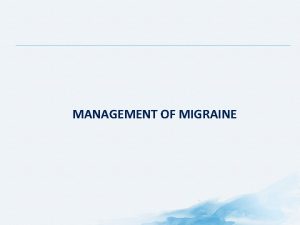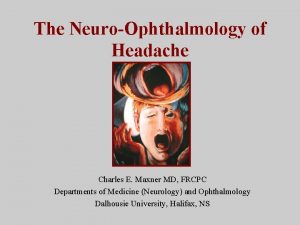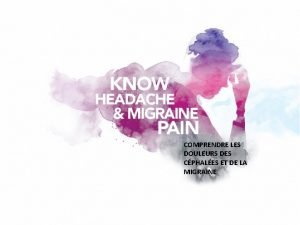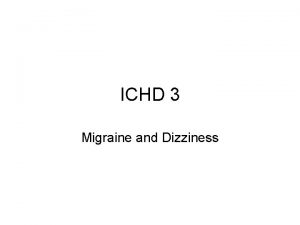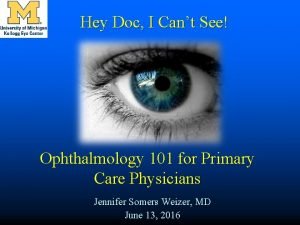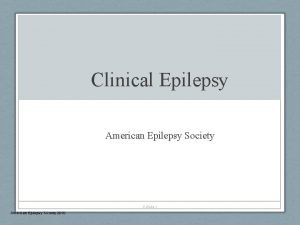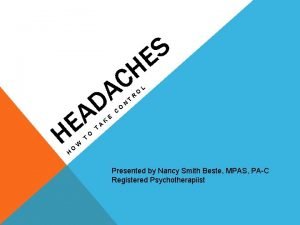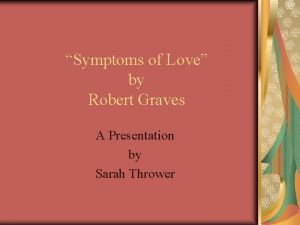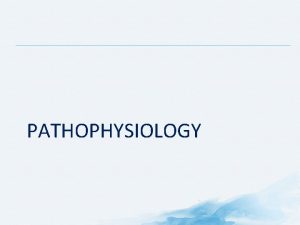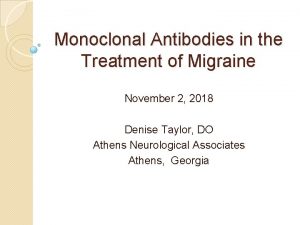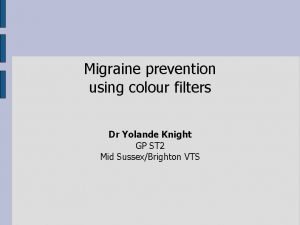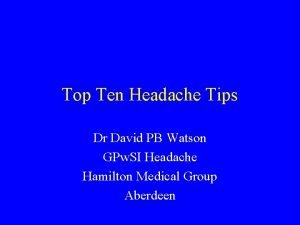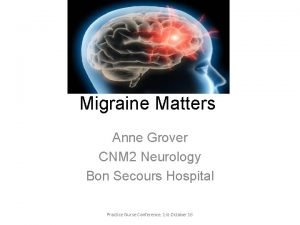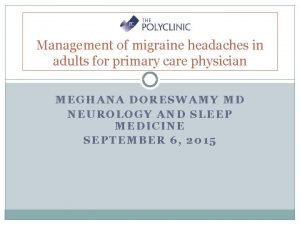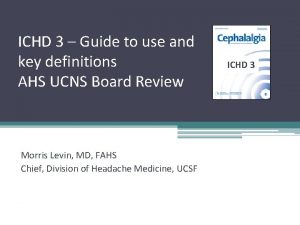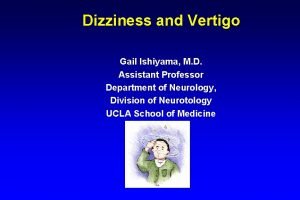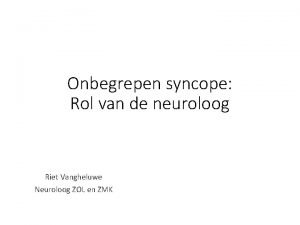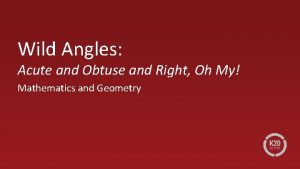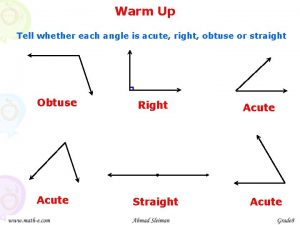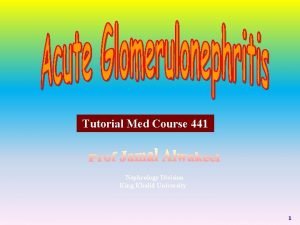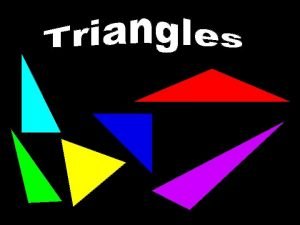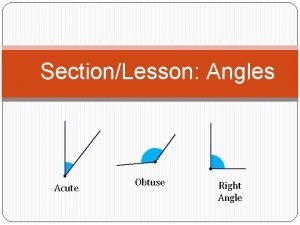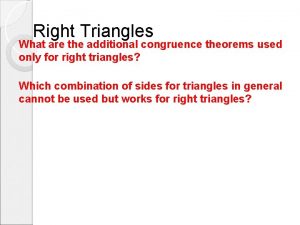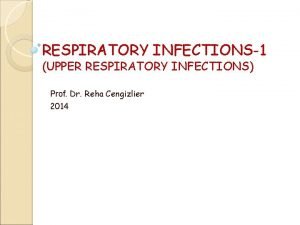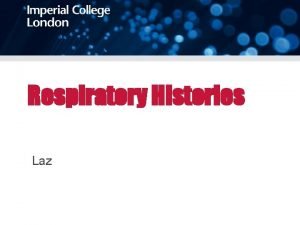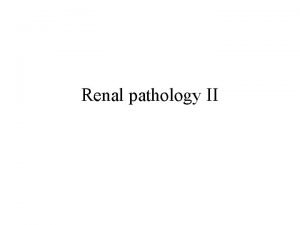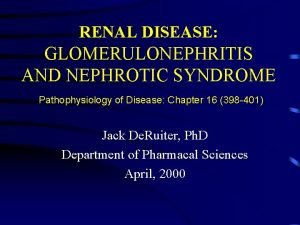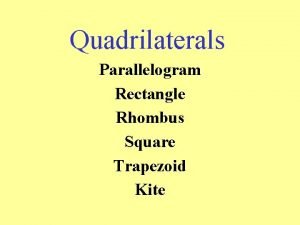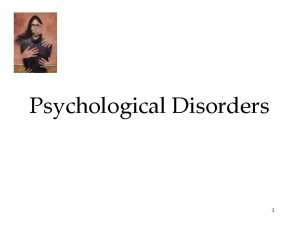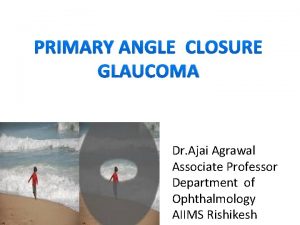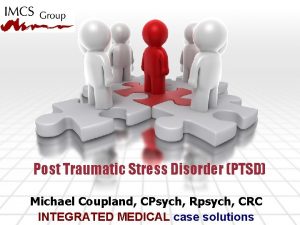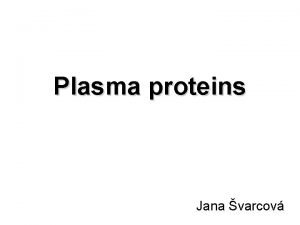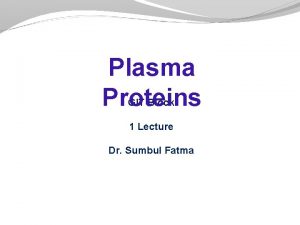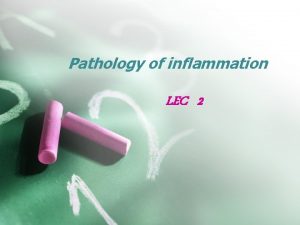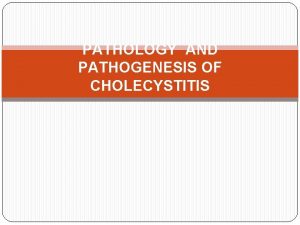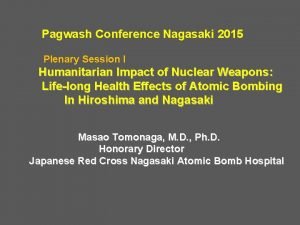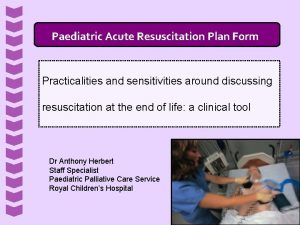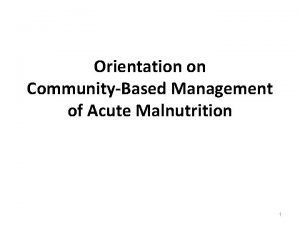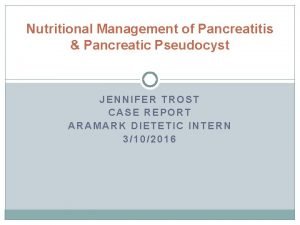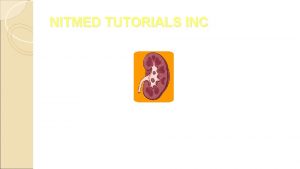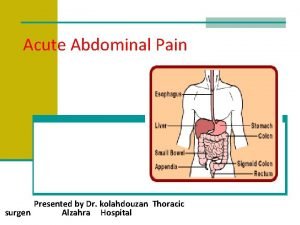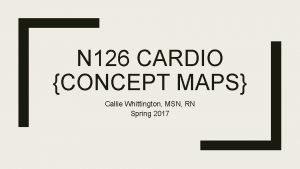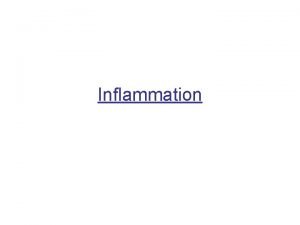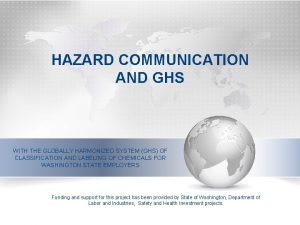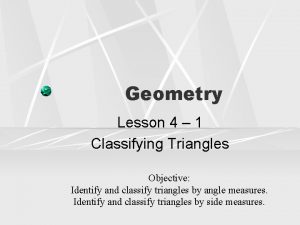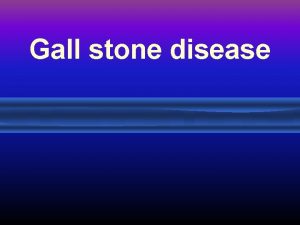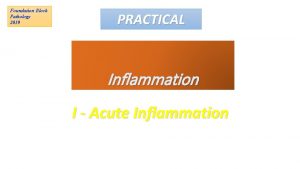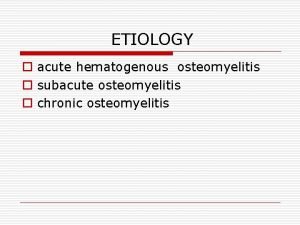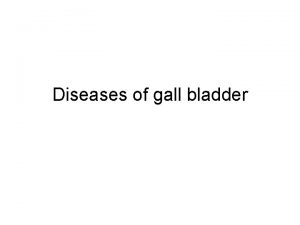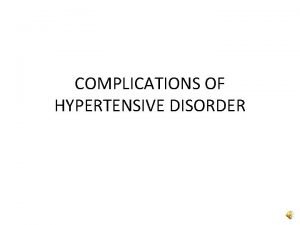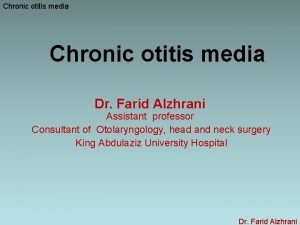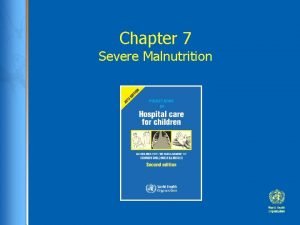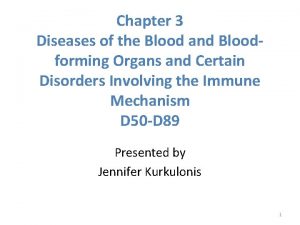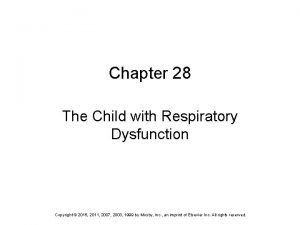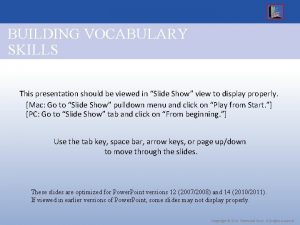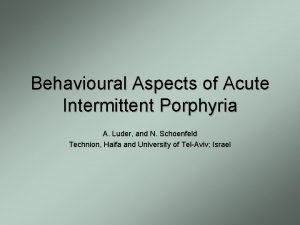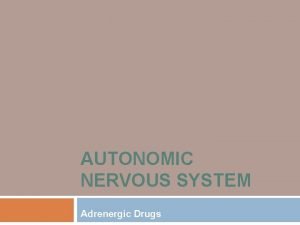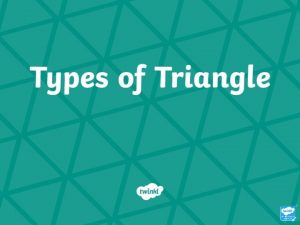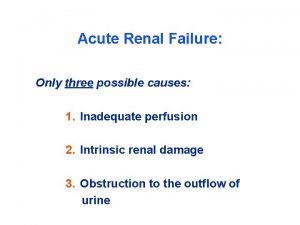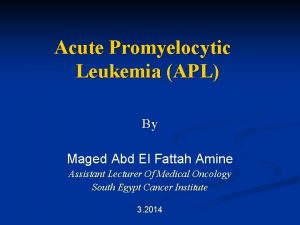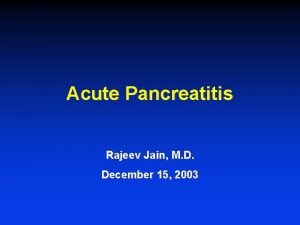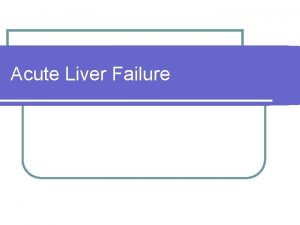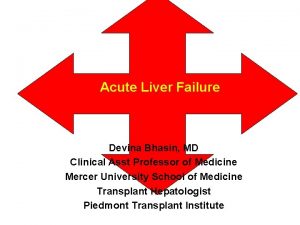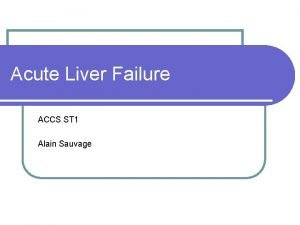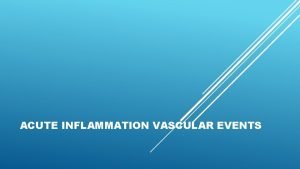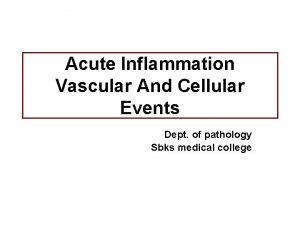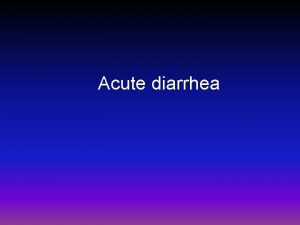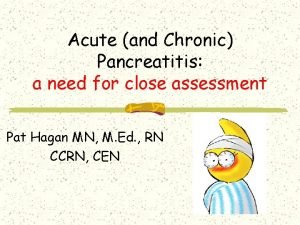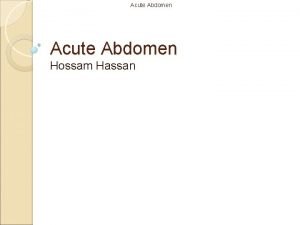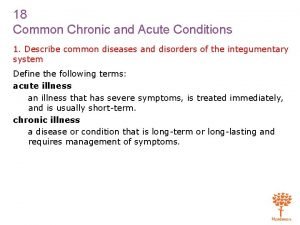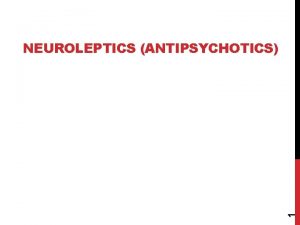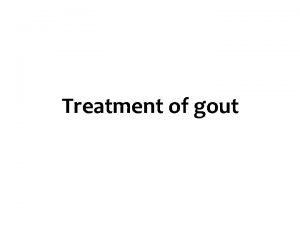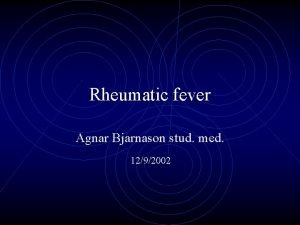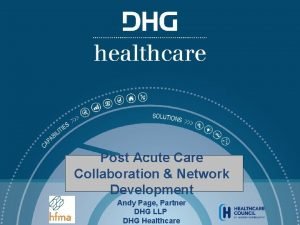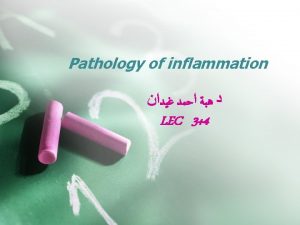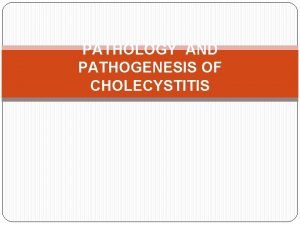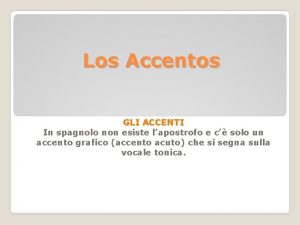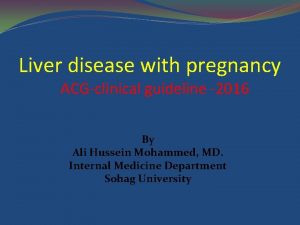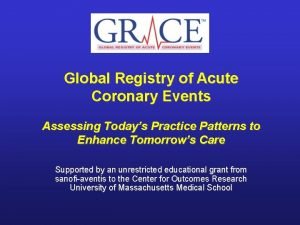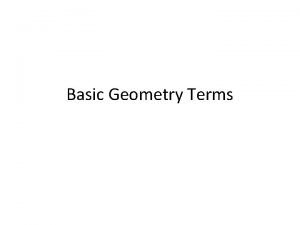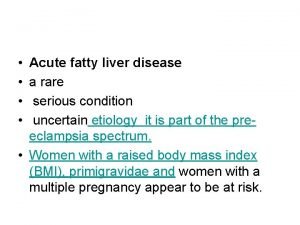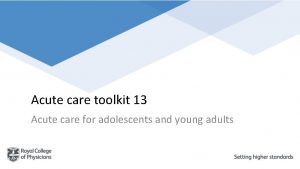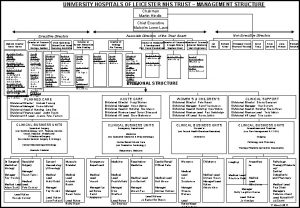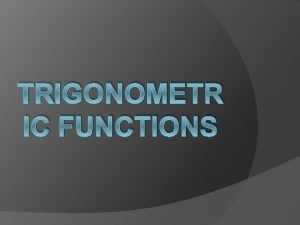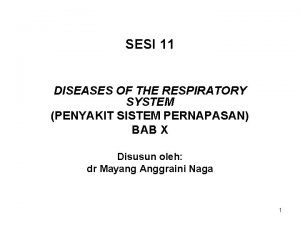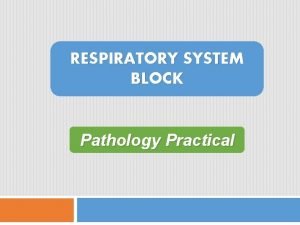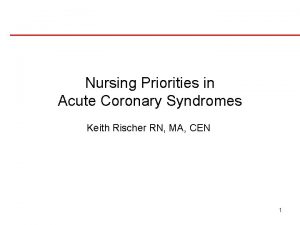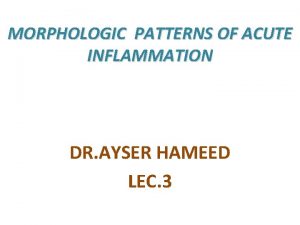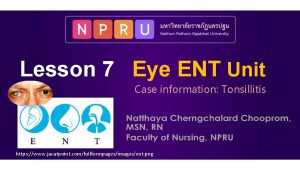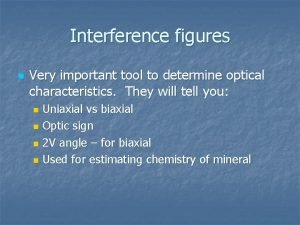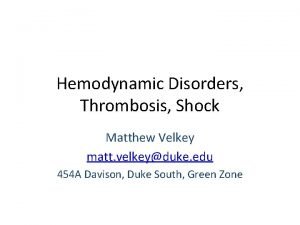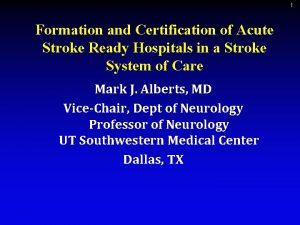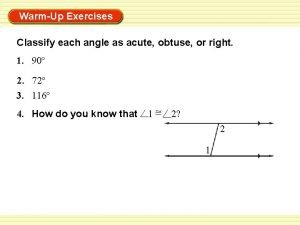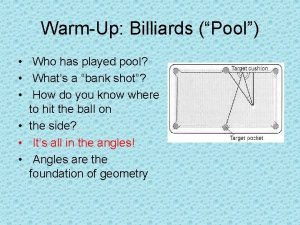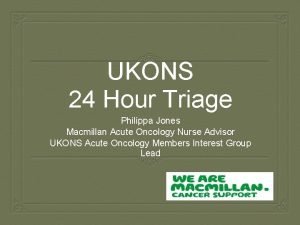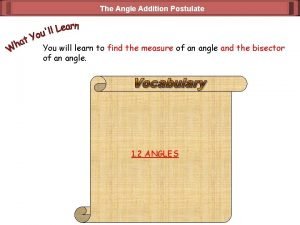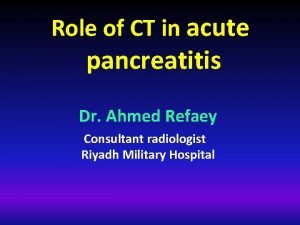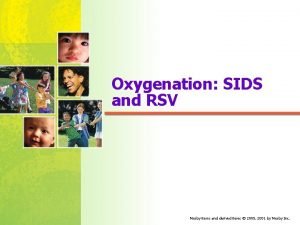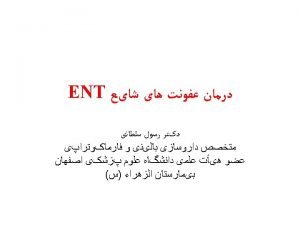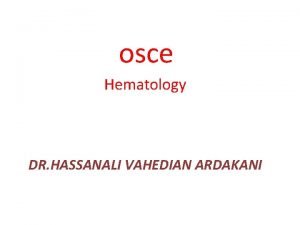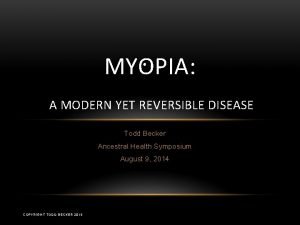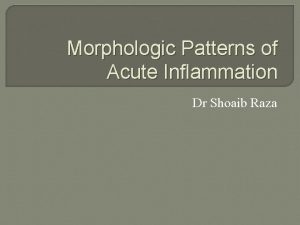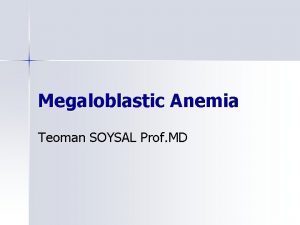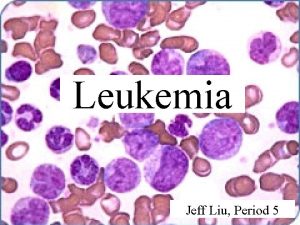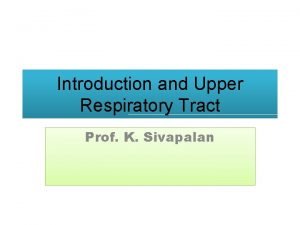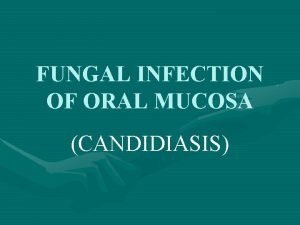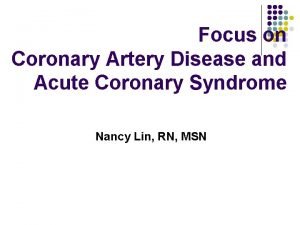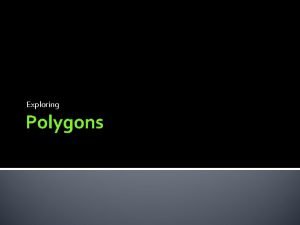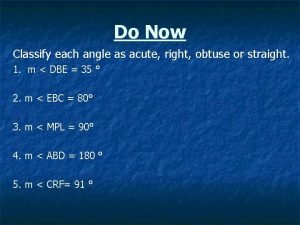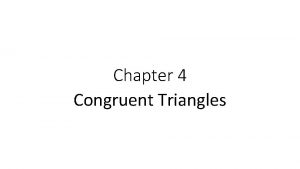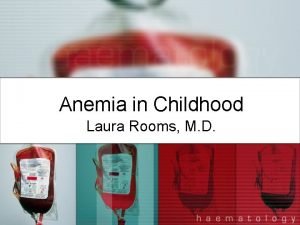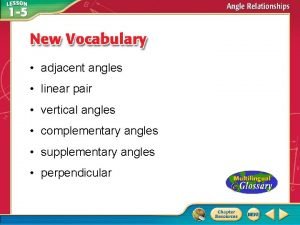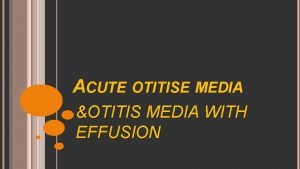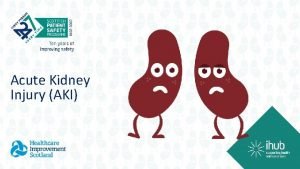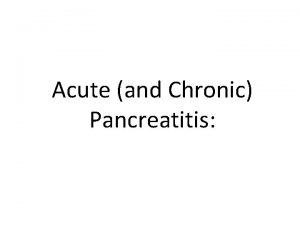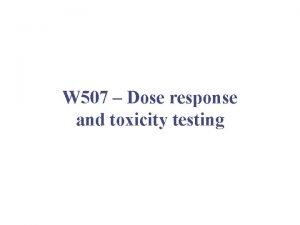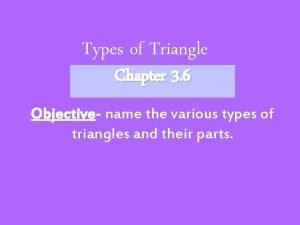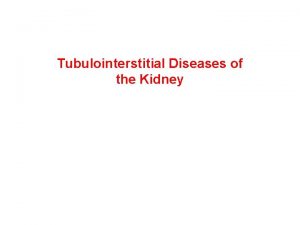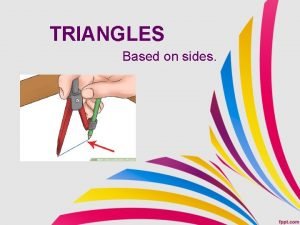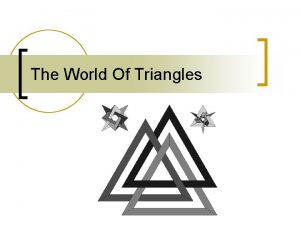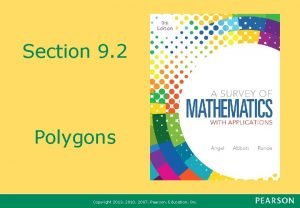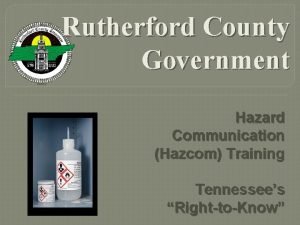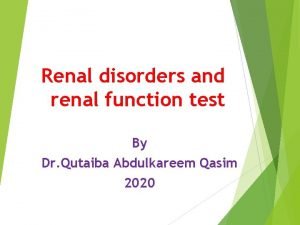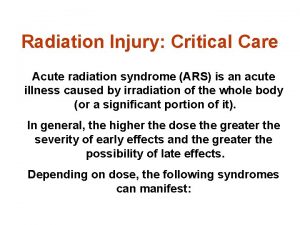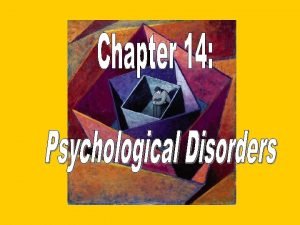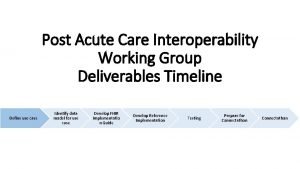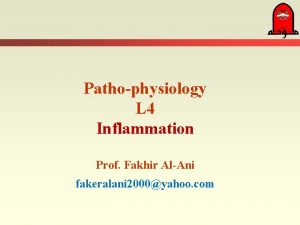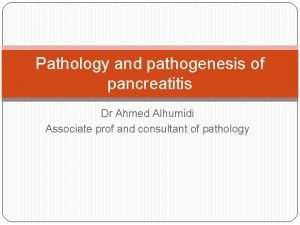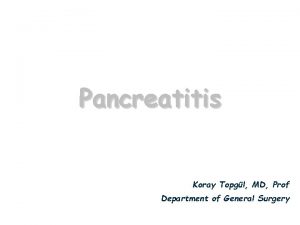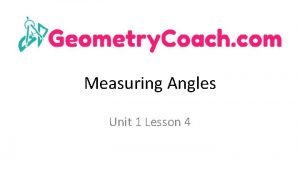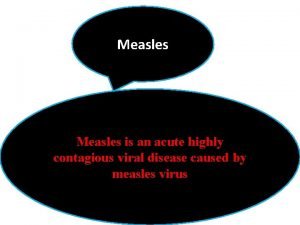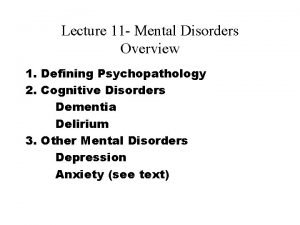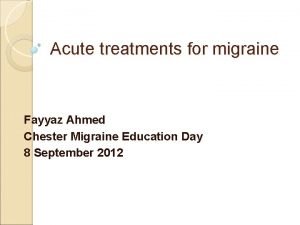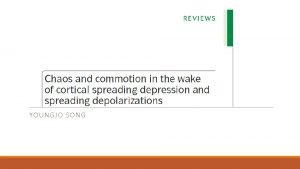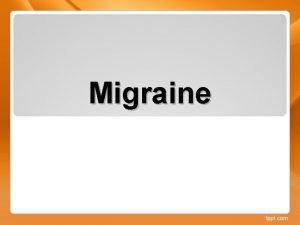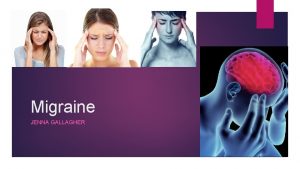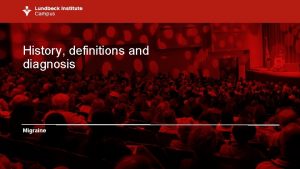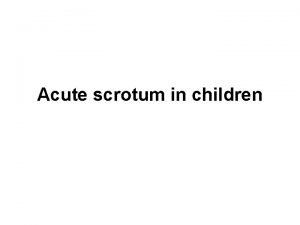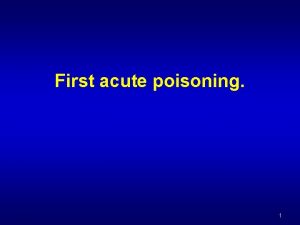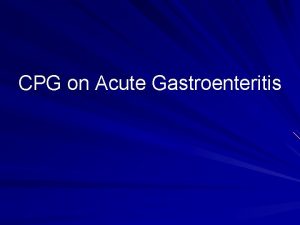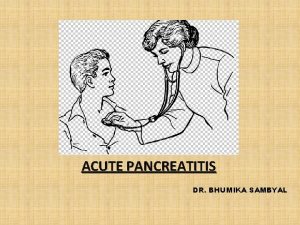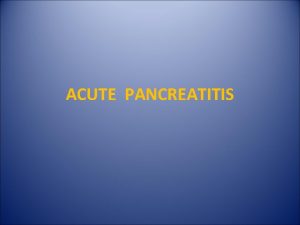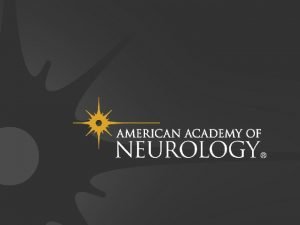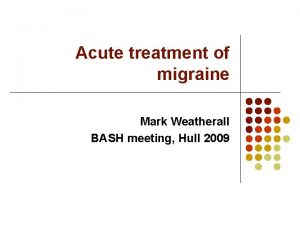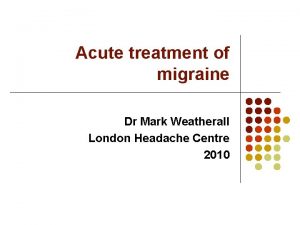MANAGEMENT OF MIGRAINE Management of Migraine Acute Strategies






































































































































































- Slides: 166

MANAGEMENT OF MIGRAINE

Management of Migraine Acute Strategies To interrupt attacks Preventative Strategies To prevent attack recurrence Pre-emptive Strategies Used when a known headache trigger exists Fumal A, Schoenen J. Neuropsychiatr Dis Treat. 2008; 4(6): 1043 -57; American Headache Society. Brainstorm. 2004. Available at: http: //www. americanheadachesociety. org/assets/1/7/Book_-_Brainstorm_Syllabus. pdf. Accessed 04 December, 2014.

Goals of Management of Migraine

Goals of Acute Treatment for Migraine • • • Treat attacks quickly and consistently and avoid recurrence Restore patient function in personal, social, and work domains Minimize the use of backup and rescue medications Eliminate or minimize adverse events Optimize self-care and reduce the need for resource use Provide cost-effective care American Headache Society. Brainstorm. 2004. Available at: http: //www. americanheadachesociety. org/assets/1/7/Book_-_Brainstorm_Syllabus. pdf. Accessed 04 December,

U. S. Headache Consortium – Goals for Migraine Treatment Goals for Successful Treatment of Acute Migraine Attacks • Treat migraine attacks rapidly and consistently without recurrence • Restore patient’s ability to function • Minimize use of back-up and rescue medications • Optimize self-care for overall management • Cause minimal or no adverse effects Goals of Long-term Migraine Management Reduce migraine frequency and severity Reduce disability Improve quality of life Prevent headache Avoid escalation of headache medication use • Educate and enable patients to manage their disease • • • Matchar DB et al. Available at: http: //tools. aan. com/professionals/practice/pdfs/gl 0087. pdf. Accessed 27 November, 2014.

Trigger Identification and Avoidance

Evaluating Migraine Triggers • • • A trigger causes headache within 24 h >50% of the time Do not confuse triggers with the cause of headache Not all triggers act equally to provoke headache There may be a “load” factor The presence of multiple triggers or a combination of particular triggers may be needed to provoke headache Patients should be advised to avoid known triggers if possible and counselled on lifestyle and stress management American Headache Society. Brainstorm. 2004. Available at: http: //www. americanheadachesociety. org/assets/1/7/Book_-_Brainstorm_Syllabus. pdf. Accessed 04 December,

Common Migraine Triggers American Headache Society. Brainstorm. 2004. Available at: http: //www. americanheadachesociety. org/assets/1/7/Book_-_Brainstorm_Syllabus. pdf. Accessed 04 December, 2014; Chawla J. 2014. Available at http: //emedicine. medscape. com/article/1142556 -overview. Accessed 05 January 2014.

Individualized Management Strategies

Considerations when Planning Acute Treatment in Migraine • Patient age • Current health status • Coexistent illnesses • Migraine type It is important to use a patient-centered approach when planning acute treatment in migraine American Headache Society. Brainstorm. 2004. Available at: http: //www. americanheadachesociety. org/assets/1/7/Book_-_Brainstorm_Syllabus. pdf. Accessed 04 December,

Considerations when Selecting a Medication for Acute Treatment of Migraine • • • Frequency of headaches Severity of headaches How quickly the headache builds Duration of the headache Tendency for headache recurrences Disability caused by headaches • As disability increases, non-specific treatments are less liable to work Associated symptoms (e. g. , nausea) Previous response to therapy Adverse events associated with medications Patient preference American Headache Society. Brainstorm. 2004. Available at: http: //www. americanheadachesociety. org/assets/1/7/Book_-_Brainstorm_Syllabus. pdf. Accessed 04 December,

Selecting appropriate treatment for each patient (individualization of treatment after diagnosis and assessment of impact of migraine by considering all treatment modalities, including non-pharmacological)

Many Factors Must Be Considered when Treating a Patient with Migraine Impact of pain Comorbid conditions Disease status Cause of Pain syndrome Pathogenesis Quality of life Other Factors Portenoy RK. Lancet. 2011; 377(9784): 2236 -47. Psychosocial factors

Overview of Treatment of Migraine

Overview of Acute Pain Management in Patients with Migraine Type of Migraine Suggested Medications Mild to moderate attacks • NSAIDs (oral) or severe attacks that have • Combination analgesics with caffeine responded to similar • Isometheptene combinations agents in the past Moderate to severe or mild to moderate attacks that respond poorly to NSAIDs • Migraine-specific drugs (e. g. , triptans, DHE) Or • Combination therapy (e. g. , ASA + acetaminophen + caffeine) Or • Other drugs (e. g. , ergotamine) Severe attacks that do not respond to other • Self-administered rescue medication treatments • Limit and carefully monitor the use of opiates and butalbital analgesics • Migraine accompanied by nausea or vomiting: use a non-oral route of administration ASA = acetylsalicylic acid; DHE = dihydroergotamine Aukerman G et al. Am Fam Physician. 2002; 66(11): 2123 -30.

Non-pharmacological Management of Migraine

Multimodal Pain Management Physiotherapy Psychotherapy/CBT No m is un odality reco iversally mm ende d Complementary therapies CBT = cognitive behavioral therapy Patient education

Patients Who Will Benefit from Non-drug Therapies for Migraine Poor tolerance for specific medications Contraindications to specific medications Insufficient or no response to medications Pregnant/nursing women or those who are planning pregnancy • History of long-term, frequent, or excessive use of acute medications that have aggravated their headaches • Significant stress • • TENS = transcutaneous electrical nerve stimulation American Headache Society. Brainstorm. 2004. Available at: http: //www. americanheadachesociety. org/assets/1/7/Book_-_Brainstorm_Syllabus. pdf. Accessed 04 December,

Non-pharmacologic Therapy for Migraine Therapy Comments Massage Spinal manipulation Hyperbaric oxygen Percutaneous estradiol • Varying degrees of efficacy Herbal supplements Dietary supplements • Range from effective to unclear efficacy Yoga • Reduces migraine frequency and associated clinical features Acupuncture • Conflicting data • One study showed acupuncture was more effective than topiramate in chronic migraine prophylaxis Surgery • Surgical manipulation of ≥ 1 migraine trigger site can successfully eliminate or reduce the frequency, duration, and intensity of migraine headache in a lasting manner Holland S et al. Neurology. 2012; 78(17): 1346 -53; Lester M. 2012. Available at: http: //nccam. nih. gov/sites/nccam. nih. gov/files/D 462. pdf. Accessed 14 December, 2014; John PJ et al. Headache. 2007; 47(5): 654 -61; Mauskop A. Continuum (Minneap Minn). 2012; 18(4): 796 -806; Linde K et al. JAMA. 2005; 293(17): 2118 -25; Yang CP et al. Cephalalgia. 2011; 31(15): 1510 -21; Guyuron Bet al. Plast Reconstr Surg. 2009; 124(2): 461 -8; Guyuron B et al. Plast Reconstr Surg. 2011; 127(2): 603 -8.

Complementary Health Approaches for Migraine Prevention • Mind and body interventions • Relaxation training • Biofeedback • Acupuncture* • Tai Chi • Yoga • Cognitive Behavioral Therapy • Aerobic exercise • Massage • Spinal manipulation • Hyperbaric oxygen • Percutaneous estradiol† • Dietary supplements Therapies vary in efficacy in treating migraine *Conflicting data exist †Increased risk of migraine after discontinuation of estradiol Holland S et al. Neurology. 2012; 78(17): 1346 -53; Lester M. 2012. Available at: http: //nccam. nih. gov/sites/nccam. nih. gov/files/D 462. pdf. Accessed 14 December, 2014; John PJ et al. Headache. 2007; 47(5): 654 -61; Mauskop A. Continuum (Minneap Minn). 2012; 18(4): 796 -806.

Complementary Health Approaches for Migraine • • Some alternative therapies may be helpful Often have a very low risk of serious side effects Many are less costly than pharmacologic therapies Considering the combination of efficacy, minimal side effects, and cost savings, it may be helpful to prescribe medications in combination with non-pharmacologic therapies Do not replace proven conventional medical treatments for migraine with unproven products or practices. Mauskop A. Continuum (Minneap Minn). 2012; 18(4): 796 -806.

Herbal Preparations, Dietary Supplements and Other Interventions for Migraine Prevention Preparation Butterbur Efficacy Effective Feverfew Magnesium Riboflavin Probably effective Coenzyme Q 10 Estrogen* Omega-3 fatty acids Hyperbaric oxygen Efficacy unclear *Increased risk of migraine after discontinuation of estradiol Holland S et al. Neurology. 2012; 78(17): 1346 -53; Lester M. 2012. Available at: http: //nccam. nih. gov/sites/nccam. nih. gov/files/D 462. pdf. Accessed 14 December, 2014; John PJ et al. Headache. 2007; 47(5): 654 -61.

Yoga for Migraine • Patients with migraine without aura were taught yoga • Yoga group was taught techniques to practice at prodromal stage of migraine, whenever possible • 60 minutes 5 days/week for 3 months • Included: • Yoga postures • Breathing practices • Relaxation practices and meditation • Yoga group patients were not to practice during headache, resolution, and postdrome stage John PJ et al. Headache. 2007; 47(5): 654 -61.

Yoga for Migraine Yoga significantly reduced migraine frequency and associated clinical features when practised for 3 months by migraine sufferers HADS = hospital anxiety depression scale; S-PRI = sensory pain rating index; A-PRI = affective pain rating index; T-PRI = total pain rating index; evaluative overall intensity of total pain experience; pain-visual analog scale John PJ et al. Headache. 2007; 47(5): 654 -61.

Surgical Treatment for Migraine • 75 patients underwent surgery (n=49) or sham surgery (n=26) • Three trigger sites identified: frontal, temporal, occipital • More patients (83. 7%) in actual surgery group experienced ≥ 50% reduction in migraine than sham surgery patients (57. 7%) (p<0. 05) • More patients (57. 1%) in actual surgery group reported complete elimination of migraine (vs. 3. 8% in sham surgery group; p<0. 001) • Compared with control group, actual surgery group demonstrated significant improvements in all validated migraine measurements at one year • Improvements were not dependent on trigger site • Most common surgical complication: slight hollowing of temple in group with temporal migraine Surgical deactivation of peripheral migraine trigger sites is an effective alternative for patients who suffer from frequent moderate to severe migraines that are difficult to manage using standard protocols. Guyuron Bet al. Plast Reconstr Surg. 2009; 124(2): 461 -8; Guyuron B et al. Plast Reconstr Surg. 2011; 127(2): 603 -8.

Surgical Treatment for Migraine – Results at 5 Years Baseline, 1 - and 5 -Year Follow-Up, and Mean Change from Baseline at 5 Years after Surgery Based on 5 -year follow-up data, strong evidence suggests surgical manipulation of ≥ 1 migraine trigger site can successfully eliminate or reduce the frequency, duration, and intensity of migraine headache in a lasting manner Guyuron Bet al. Plast Reconstr Surg. 2009; 124(2): 461 -8; Guyuron B et al. Plast Reconstr Surg. 2011; 127(2): 603 -8.

Neuromodulation for Migraine • Possible treatments for chronic migraine • Occipital nerve stimulation • Supraorbital neurostimulation • Single-pulse transcranial magnetic stimulation • Vagal nerve stimulation • Sphenopalatine ganglion stimulation • Transcranial magnetic stimulation • Attention is now on non-invasive neurostimulation devices • Nerve stimulation may produce paresthesias or pain Tso AR, Goadsby PJ. Curr Treat Options Neurol. 2014; 16: 318.

Pharmacologic Management of Migraine – Acute Treatment

Principles for Acute Treatment of Migraine • Enlist patient in a therapeutic alliance • Treat headache as early in attack as possible • Tailor treatment to both individual and specific attack • Headaches vary across individuals and attacks • Limit medication use to two to three times/week • Use correct dose and give full therapeutic trial • Match drug formulation to symptom profile • Suggest behavioral strategies to minimize headache frequency and impact • Consider addition of preventative therapy • Provide acute therapy for patients receiving preventative therapy American Headache Society. Brainstorm. 2004. Available at: http: //www. americanheadachesociety. org/assets/1/7/Book_-_Brainstorm_Syllabus. pdf. Accessed 04 December,

Acute Treatment in Migraine • • • May be sufficient for patients who suffer infrequent attacks Must consider patient preference and contraindications Drug should be taken as soon as headache component of attack is realized Drug dose should be high enough to be fully effective Co-administration of anti-emetic or pro-kinetic drugs may help with absorption of primary drug and increase its speed of action and efficacy • Overuse of any acute anti-migraine drug may induce chronification and medication overuse headache • Severity and response to treatment vary between attacks • Patients may need prescriptions for several drugs of increasing potency to manage their attacks to allow for a combined stratified and step-wise medication strategy Fumal A, Schoenen J. Neuropsychiatr Dis Treat. 2008; 4(6): 1043 -57.

Stepwise Approach to Treatment of Acute Migraine Step 1 Over-the-counter analgesics Step 2 Triptan Step 1 Triptan + NSAID = non-steroidal antiinflammatory drug Best Pract J. 2014; 62: 28 -36. http: //www. bpac. org. nz/BPJ/2014/July/docs/BPJ 62 -triptans. pdf An anti-emetic can be added at any step

Pharmacological Treatment of Migraine (1) Drug(s) Comments Acetaminophen • Limited data to support use as monotherapy in migraine ASA • Monotherapy may benefit some patients • Doses required may not be tolerated by some patients • Significant risk of GI adverse events • Caffeine enhances absorption and may potentiate activity • Role of combination in moderate to severe migraine not ASA + acetaminophen + supported by clinical trials caffeine • Increased potential for MOH • ASA side effects + caffeine side effects (insomnia, restlessness, palpitations) NSAIDs/coxibs • Effective for mild to severe migraine • Improves pain free periods and decreases pain and migraine -associated symptoms • Significant risk of GI adverse events ASA = acetylsalicylic acid; coxib = cyclooxygenase inhibitor; GI = gastrointestinal; NSAID = non-steroidal anti-inflammatory drug Demaagd G. P T. 2008; 33(7): 404 -16; Aukerman G et al. Am Fam Physician. 2002; 66(11): 2123 -30.

Pharmacological Treatment of Migraine (2) Drug(s) Comments Barbiturates (especially butalbital) • Used for many years but no data support use • Associated with a variety of adverse events • Patients regularly using barbiturates be evaluated and provided with an alternative therapy Opioids • Use should be limited in treatment of migraine • Short-term use may be appropriate in some patients • Use must be vigilantly monitored Triptans • Rapid onset of action • High efficacy • Favourable side effect profile Ergot alkaloids • Long history of use and low cost, but many possible associated adverse events • Largely been replaced by triptans Complex pharmacology and potential drug interactions (notably triptans) • Erratic pharmacokinetics Demaagd G. P T. 2008; 33(7): 404 -16; Silberstein SD. Neurology. 2000; 55(6): 754 -762; Silberstein SD et al. Headache in Clinical Practice. Oxford, England: Isis Medical Media; 1998; Goadsby PJ et al. N Engl J Med. 2002; 346(4): 257 -70.

Stratified Care for Migraine P<0. 001 for stratified care vs. step care across attacks (*) and for stratified care vs. step care within attacks (†) Lipton RB et al. JAMA. 2000; 284(20): 2599 -605.

Acute Treatment: Mechanism-based Management of Migraine

Simple Analgesics for the Acute Treatment of Migraine • Three general classes • Acetaminophen • Acetylsalicylic acid (ASA) (alone or in combination) • Non-steroidal anti-inflammatory drugs (NSAIDs) Demaagd G. P T. 2008; 33(7): 404 -16.

Acetaminophen for Acute Treatment of Migraine • Limited data support use of acetaminophen as monotherapy in acute management of migraine • One placebo-controlled trial reported benefits with 1, 000 mg in mild-to-moderate migraine • Comparison trials with NSAIDs reported greater efficacy with NSAIDs Acetaminophen’s mechanism of action is probably achieved through a central mechanism related to prostaglandin inhibition NSAID = non-steroidal anti-inflammatory drug Demaagd G. P T. 2008; 33(7): 404 -16.

Acetaminophen • Action at molecular level is unclear • Potential mechanisms include: – Inhibition of COX enzymes (COX-2 and/or COX-3) – Interaction with opioid pathway – Activation of serotoninergic bulbospinal pathway – Involvement of nitric oxide pathway – Increase in cannabinoid-vanilloid tone COX = cyclooxygenase Mattia A, Coluzzi F. Minerva Anestesiol 2009; 75(11): 644 -53.

ASA for the Acute Treatment of Migraine • Monotherapy may benefit some patients • Required doses are not always tolerated by patients with gastrointestinal symptoms • May be benefits vs. placebo with 900 -1000 mg in mild to severe migraine • Mechanism of action probably similar to that of other NSAIDs that act on anti-inflammatory response in migraine • Possible associated adverse events • Gastrointestinal upset • Suppositories may cause rectal irritation ASA should probably be reserved as a second-line or third-line option ASA = acetylsalicylic acid Demaagd G. P T. 2008; 33(7): 404 -16; Aukerman G et al. Am Fam Physician. 2002; 66(11): 2123 -30.

ASA + Acetaminophen + Caffeine for the Acute Treatment of Migraine • Caffeine enhances absorption and may potentiate activity • May relieve headache intensity and migraine-associated symptoms (nausea, vomiting) in patients with mild to moderate migraine • Similar or greater efficacy with combination vs. other simple analgesics • Possible adverse events • Increased potential for medication overuse headache • Caffeine can lead to insomnia, restlessness, and palpitations Role of this combination in moderate to severe migraine has not been demonstrated in clinical trials ASA = acetylsalicylic acid Demaagd G. P T. 2008; 33(7): 404 -16.

NSAIDs/Coxibs for the Acute Treatment of Migraine • Effective in abortive therapy of mild to severe migraine • Improvement in pain-free periods, reductions in pain intensity and migraine-associated symptoms • Combination with caffeine or other abortive agents – including triptans – may offer additional benefit in some patients • Proposed mechanism of action is via anti-inflammatory effects on vasoactive peptide-induced inflammation that may occur during migraine • Possible adverse events • Gastrointestinal • Addition of metoclopramide may improve tolerability NSAIDs may be appropriate as acute migraine therapy in patients with infrequent, mild to severe attacks who experience minimal GI symptoms Coxib = cyclooxygenase inhibitor; NSAID = non-steroidal anti-inflammatory drug Demaagd G. P T. 2008; 33(7): 404 -16.

What Are NSAIDs (ns. NSAIDs/coxibs)? NSAID = Non-Steroidal Anti-Inflammatory Drug • Analgesic effect via inhibition of prostaglandin production • Broad class incorporating many different medications: ns. NSAIDs: – ASA – Diclofenac – Ibuprofen – Naproxen Coxibs: – Celecoxib – Etoricoxib ASA = acetylsalicylic acid; coxib = COX-2 -specific inhibitor; ns. NSAID = non-specific non-steroidal anti-inflammatory drug Brune K. In: Kopf A et al (eds). . Guide to Pain Management in Low-Resource Settings International Association for the Study of Pain; Seattle, WA: 2010.

How Do ns. NSAIDs/Coxibs Work? Arachidonic acid COX-2 (induced by inflammatory stimuli) COX-1 (constitutive) BLOCK Coxibs BLOCK ns. NSAIDs BLOCK Prostaglandins Gastrointestinal cytoprotection, platelet activity Inflammation, pain, fever Pain relief Coxib = cyclooxygenase-2 -specific inhibitor; NSAID = non-steroidal anti-inflammatory drug; ns. NSAID = non-specific NSAID Gastrosource. Non-steroidal Anti-inflammatory Drug (NSAID)-Associated Upper Gastrointestinal Side-Effects. Available at: http: //www. gastrosource. com/11674565? item. Id=11674565. Accessed: December 4, 2010; Vane JR, Botting RM. Inflamm Res 1995; 44(1): 1 -10.

Adverse Effects of ns. NSAIDs/Coxibs All NSAIDs • Gastroenteropathy - gastritis, bleeding, ulceration, perforation • Cardiovascular thrombotic events • Renovascular effects – Decreased renal blood flow – Fluid retention/edema – Hypertension • Allergic phenomenon Cox-1 -mediated NSAIDs (ns. NSAIDs) • Decreased platelet aggregation Coxib = cyclooxygenase-2 -specific inhibitor; NSAID = non-steroidal anti-inflammatory drug; ns. NSAID = non-specific NSAID Clemett D, Goa KL. Drugs 2000; 59(4): 957 -80; Grosser T et al. In: Brunton L et al (eds. ). Goodman and Gilman’s The Pharmacological Basis of Therapeutics. 12 th ed. (online version). Mc. Graw-Hill; New York, NY: 2010.

Barbiturates for Acute Treatment of Migraine • Combination products used for many years for migraine • No data support use of butalbital • Available in combination with acetaminophen or ASA (± codeine) • Possible adverse events • Central nervous system depression and confusion • Negative effects on cognition • May case paradoxical excitation • Medication overuse headache • Can lead to abuse and dependency Although butalbital is considered an abortive therapy in migraine, patients regularly using barbiturates should be evaluated and provided with an alternative therapy ASA = acetylsalicylic acid Demaagd G. P T. 2008; 33(7): 404 -16.

Opioid Analgesics for the Acute Treatment of Migraine • Limit/avoid use due to potential for: • Overuse • Abuse • Tolerance • Risk of medication overuse headache • Possibility of opioid-induced hyperalgesia in some patients • Short-term use may be appropriate in some patients: • Women with intractable menstrual migraine • Pregnant women • The elderly • Patients with severe and debilitating head pain who are intolerant of or unresponsive to other medications Use of opioid analgesics should be vigilantly monitored by patients, their family members, and their health care professionals ASA = acetylsalicylic acid Demaagd G. P T. 2008; 33(7): 404 -16.

How Opioids Affect Pain Modify perception, modulate transmission and affect transduction by: Brain • Altering limbic system activity; modify sensory and affective pain aspects • Activating descending pathways that modulate transmission in spinal cord • Affecting transduction of pain stimuli to nerve impulses Transduction Transmission Perception Descending modulation Ascending input Nociceptive afferent fiber Spinal cord Reisine T, Pasternak G. In: Hardman JG et al (eds). Goodman and Gilman’s: The Pharmacological Basics of Therapeutics. 9 th ed. Mc. Graw-Hill; New York, NY: 1996; Scholz J, Woolf CJ. Nat Neurosci 2002; 5(Suppl): 1062 -7; Trescot AM et al. Pain Physician 2008; 11(2 Suppl): S 133 -53.

Adverse Effects of Opioids System Adverse effects Gastrointestinal Nausea, vomiting, constipation CNS Cognitive impairment, sedation, lightheadedness, dizziness Respiratory depression Cardiovascular Orthostatic hypotension, fainting Other Urticaria, miosis, sweating, urinary retention CNS = central nervous system Moreland LW, St Clair EW. Rheum Dis Clin North Am 1999; 25(1): 153 -91; Yaksh TL, Wallace MS. In: Brunton L et al (eds). Goodman and Gilman’s The Pharmacological Basis of Therapeutics. 12 th ed. (online version). Mc. Graw-Hill; New York, NY: 2010.

Triptans for Acute Treatment of Migraine • • Selective 5 -HT 1 B/1 D/1 F agonists Rapid onset of action (15 to 60 min) High efficacy Favourable side effect profile Silberstein SD. Neurology. 2000; 55(6): 754 -762; Silberstein SD et al. Headache in Clinical Practice. Oxford, England: Isis Medical Media; 1998.

How Do Triptans Work to Relieve Migraine? Possible Sites of Action of Triptans in the Trigeminovascular System Goadsby PJ et al. N Engl J Med. 2002; 346(4): 257 -70.

Triptans: Treatment Choices Sumatriptan • Tablet and fast-disintegrating • Injection • Nasal spray Rizatriptan • Tablet and melt Zolmitriptan • Tablet and melt • Nasal spray Almotriptan • Tablet Naratriptan • Tablet Frovitriptan • Tablet Eletriptan • Tablet Ferrari MD et al. Lancet. 2001; 358(9294): 1668 -75; Worldwide Product Safety and Pharmacovigilance Document. December 1999.

Choosing a Triptan • All triptans have similar efficacy • Base choice on patient preference • Patients often prefer oral therapy • Vomiting and nausea may preclude use of oral treatment consider subcutaneous or nasal formulations • Patients who do not respond to one triptan may respond to a different one • Try an alternative triptan in a subsequent attack • Patients who do not respond to oral triptans should be encouraged to try subcutaneous formulations Best Pract J. 2014; 62: 28 -36. http: //www. bpac. org. nz/BPJ/2014/July/docs/BPJ 62 -triptans. pdf

Prescribing Triptans and Monitoring Use • Most effective if taken early in a migraine attack • Do not take during aura phase • Dose should not be repeated if there is no response • Dose can be repeated after two to four hours if there was initial relief from the migraine and it has reoccurred • Avoid using triptans for ≥ 10 days/month A triptan should be taken early during a migraine attack A triptan should not be taken during the aura phase In absence of a response, the dose of triptan should not be repeated Best Pract J. 2014; 62: 28 -36. http: //www. bpac. org. nz/BPJ/2014/July/docs/BPJ 62 -triptans. pdf

Triptans: Contraindications • • • Pregnancy Lactation Ischemic stroke Ischemic heart disease Prinzmetal’s angina Raynaud’s disease MAO = monoamine oxidase Belvís R et al. Recent Pat CNS Drug Discov. 2009; 4(1): 70 -81. • • • Uncontrolled hypertension Severe liver or renal failure Familial hemiplegic migraine Basilar migraine Ergotamine therapy MAOI therapy

Triptans: Drug-drug Interactions • Contraindicated in patients either currently taking MAOIs or within two weeks of stopping an MAOI • Due to increase in bioavailability of triptans • Small risk of serotonin syndrome in patients taking triptans concurrently with SSRIs, SNRIs, or St. John’s wort • Theoretical risk of additive vasoconstriction and possible significant coronary vasoconstriction with combined use of triptans and ergot derivatives • Combination is generally contraindicated MAOI = monoamine oxidase inhibitor; SNRI = serotonin-norepinephrine reuptake inhibitor; SSRI = selective serotonin reuptake inhibitor Best Pract J. 2014; 62: 28 -36. http: //www. bpac. org. nz/BPJ/2014/July/docs/BPJ 62 -triptans. pdf

Triptans - Precautions • Limit use to ≤ 2 days/week • Do not use within 24 hour of ergotamine derivatives, other triptans, or methysergide • Screen for asymptomatic cardiac disease in patients at risk • Contraindicated in patients with risk of heart disease, basilar or hemiplegic migraine, or uncontrolled hypertension • Common adverse events: • • Transient feelings of pain or tightness in the chest or throat Tingling Heat Flushing Heaviness or pressure Drowsiness Fatigue Malaise IM = intramuscular; IV = intravenous; SC = subcutaneous American Headache Society. Brainstorm. 2004. Available at: http: //www. americanheadachesociety. org/assets/1/7/Book_-_Brainstorm_Syllabus. pdf. Accessed 04 December,

Cardiovascular Safety of Triptans • All triptans are associated with “triptan sensations” • Burning, tingling, or tightness in the face, neck, limbs, or chest 1 • Patients may be alarmed by chest pain (3 -5% of patients)1, 2 • Triptan dose may be lowered in sensitive patients 1 • Serious cardiovascular events associated with triptans 1 • Patients with multiple cardiac risk factors may need cardiac evaluation before starting triptan therapy 1 1. Best Pract J. 2014; 62: 28 -36 http: //www. bpac. org. nz/BPJ/2014/July/docs/BPJ 62 -triptans. pdf ; Belvís R et al. Recent Pat CNS Drug Discov. 2009; 4: 70 -81; 2. Belvís R. et al. Recent Pat CNS Drug Discov. 2009; 4: 70 -81.

Triptans and Serotonin Syndrome • Potential risk with concurrent use of triptans and SSRIs • Interaction appears to be rare • According to the American Headache Society, there is insufficient evidence to support limiting the use of triptans with SSRIs or SNRIs • If used with SSRIs or SNRIs, monitor for symptoms of serotonin syndrome (weakness, hyperreflexia, poor coordination) • Possible risk of serotonin syndrome if St. John’s Wort and triptans are taken concurrently SNRI = serotonin-norepinephrine reuptake inhibitor; SSRI = selective serotonin reuptake inhibitor 1. Best Pract J. 2014; 62: 28 -36. http: //www. bpac. org. nz/BPJ/2014/July/docs/BPJ 62 -triptans. pdf

Withdrawing Triptans • Triptan overuse medication overuse headache, necessitating withdrawal • Most strategies involve abrupt withdrawal of the triptan and the use of other medicines to manage symptoms • Medications useful during withdrawal include naproxen, prednisone, metoclopramide or domperidone • Prophylactic medicines for migraines may be required • Headaches often improve within two months following withdrawal • Symptoms usually get worse before this improvement is seen • Triptans may need to be reintroduced for acute migraine Review patient after two to three weeks to ensure withdrawal has been achieved. Neurology referral may be useful for patients unable to withdraw from medication. Best Pract J. 2014; 62: 28 -36. http: //www. bpac. org. nz/BPJ/2014/July/docs/BPJ 62 -triptans. pdf

Pharmacokinetic Properties of Triptans Triptan Onset of Efficacy (min) Time to Peak Levels (h) Lipophilicity Bioavailability (%) Elimination t 1/2 (h) Elimination Routes Almotriptan 45 -60 1. 5 -2. 5 Unknown 80 3. 5 Hepatic (active metabolite) Renal, MAO, CYP 60 1. 3. -2. 8 High 50 4 -5 Hepatic (active metabolite) CYP Frovatriptan Up to 4 hours 2 -4 Low 24 -30 26 Hepatic, CYP Naratriptan Up to 4 hours 2 -3. 5 High 63 -73 5 -6 Hepatic, renal, CYP Rizatriptan 30 1 Moderate 45 2 -2. 5 Hepatic, MAO, renal Sumatriptan 45 -60 2 -3 Low 14 2 -2. 5 Hepatic, MAO Zolmitriptan 45 -60 1 -1. 5 Moderate 40 -48 2. 5 -3 Hepatic (active metabolite) MAO, CYP Eletriptan Rizatriptan provides the fastest onset of efficacy CYP = cytochrome hepatic system; MAO = monoamine oxidase A Belvís R et al. Recent Pat CNS Drug Discov. 2009; 4(1): 70 -81.

Efficacy Parameters of Oral Triptans Headache Response at 2 h (%) Complete Relief of Pain at 2 h (%) 2 h Therapeutic Gain (%) Recurrence Rate at 24 h (%) 57 -65 20 -25 26 -32 18 -27 Eletriptan 40 mg 65 29 22 -41 19 -23 Eletriptan 80 mg 65 -80 37 30 -53 21 -33 Frovatriptan 2. 5 mg 38 -40 23 -28 16 -19 7 -25 Naratriptan 45 -52 21 -27 21 -22 17 -28 Rizatriptan 70 -77 40 -44 27 -40 28 -47 Sumatriptan 50 -61 30 -32 29 -36 29 -34 Zolmitriptan 2. 5 mg 64 33 34 13 -39 Zolmitriptan 5 mg 65 38 37 24 -32 Triptan Almotriptan 12. 5 mg Rizatriptan provides the best headache response and complete relief of pain at 2 h Belvís R et al. Recent Pat CNS Drug Discov. 2009; 4(1): 70 -81.

Selecting a Triptan – TRIPSTAR Main Attribute Definition Efficacy Extent to which an oral triptan can achieve and maintain pain-free status Consistency of effect Extent to which an oral triptan is efficacious in at least 2 of 3 migraine attacks Tolerability Extent to which patients remain free of AEs Lower Level Attributes Pain-free at 1 hour Pain-free at 2 hours Sustained pain-free* Freedom from CNS AEs† Freedom from CV AEs Freedom from other AEs *Pain-free by 2 h post-dose, without recurrence of moderate or severe headache and without use of headache rescue medication 2 -24 h post-dose †asthenia, abnormal dreams, agitation, aphasia, ataxia, confusion, dizziness, somnolence, speech disorder, abnormal thinking, tremor, vertigo, other focal neurological symptom AE = adverse event; CNS = central nervous system; CV = cardiovascular Lipton RB et al. Curr Med Res Opin. 2005; 21(3): 413 -24.

Selecting a Triptan – TRIPSTAR • According to migraine sufferers and physicians: • Efficacy more important than tolerability or consistency • Freedom from CV events was most important tolerability attribute • Pain free at 1 hour was the most important lower-level efficacy attribute for migraineurs • Sustained pain free was the most important lower-level efficacy attribute for physicians • Almotriptan, eletriptan, and rizatriptan were closest to hypothetical ideal triptan according to migraineurs, neurologists, and primary care providers CV = cardiovascular Lipton RB et al. Curr Med Res Opin. 2005; 21(3): 413 -24.

Ergot Alkaloids as Acute Migraine Therapy • First specific agents indicated for acute treatment of migraine • Use declined with introduction of triptans • Ergotamine tartrate and dihydroergotamine mesylate are available as injectable and nasal spray formulations • Mechanism of action includes multireceptor action at serotonergic subtypes 5 -HT 1 A, D, F, B and 5 -HTs • Leads to effects on neuropeptide release and neurogenically induced inflammation • Activity at alpha-adrenergic and dopaminergic systems may also contribute to action (but results in more side effects) HT = hydroxytryptamine Demaagd G. P T. 2008; 33(7): 404 -16.

Ergot Alkaloids as Acute Migraine Therapy • Inexpensive • Long history of use for treatment of migraines • Complex pharmacology • Potential interactions with triptans, serotonergic drugs, inhibitors of CYP 450 3 A 4 • Erratic pharmacokinetics • Lack of evidence regarding effective doses • Potent and sustained generalized vasoconstrictor effects • High risk of overuse • High risk of medication overuse headache Demaagd G. P T. 2008; 33(7): 404 -16; Goadsby PJ et al. N Engl J Med. 2002; 346(4): 257 -70.

Possible Adverse Effects of Ergot Alkaloids • • • Nausea and vomiting Muscle cramps Tingling in extremities Sense of difficulty swallowing Chest discomfort Nasal congestion Depression Fatigue Ergotism with prolonged use or overuse Demaagd G. P T. 2008; 33(7): 404 -16.

Ergot Alkaloids – Precautions Limit use to ≤ 2 days/week Do not use within 24 hours of other ergotamines or triptans Screen for asymptomatic cardiac disease in patients at risk Do not combine with CYP 3 A 4 inhibitors (e. g. , macrolide antibiotics and protease inhibitors • Potential risk for serious toxicity including vasospasm • Fibrotic complications • Retroperitoneal and/or pleuropulmonary fibrosis • Fibrotic thickening of aortic, mitral, tricuspid and/or pulmonary valves • • IM = intramuscular; IV = intravenous; SC = subcutaneous American Headache Society. Brainstorm. 2004. Available at: http: //www. americanheadachesociety. org/assets/1/7/Book_-_Brainstorm_Syllabus. pdf. Accessed 04 December, 2014; Paladin Labs Inc. Bellergal® Spacetabs product monograph. Revised February 13, 2014.

Ergot Alkaloids - Contraindications • Contraindicated in patients with risk of heart disease, basilar or hemiplegic migraine, or uncontrolled hypertension • Contraindicated with concomitant ritonavir, nelfinavir, indinavir, erythromycin, clarithromycin, troleandomycin, ketoconazole, itraconazole, or other vasoconstrictors IM = intramuscular; IV = intravenous; SC = subcutaneous American Headache Society. Brainstorm. 2004. Available at: http: //www. americanheadachesociety. org/assets/1/7/Book_-_Brainstorm_Syllabus. pdf. Accessed 04 December,

Pharmacologic Management of Migraine – Prophylaxis

Preventative Treatment: Mechanism-based Management of Migraine

Goals of Migraine Prophylaxis Reduce attack frequency Reduce attack severity Reduce attack duration Improve responsiveness to treatment of acute attacks • Improve function • Reduce disability • • American Headache Society. Brainstorm. 2004. Available at: http: //www. americanheadachesociety. org/assets/1/7/Book_-_Brainstorm_Syllabus. pdf. Accessed 04 December,

Prophylactic Therapy in Migraine • Must be individually tailored to each patient • Consider: • Degree of disability • Demands • Expectations • Previous medication history • Migraine subtype • Comorbid disorders There is no uniformly accepted criterion for the timing of preventative treatment Fumal A, Schoenen J. Neuropsychiatr Dis Treat. 2008; 4(6): 1043 -57.

EFNS Guidelines for Initiating Migraine Prophylaxis Consider and discuss prophylactic therapy with patient when: • Quality of life, business duties, or school attendance are severely impaired • Patient experiences ≥ 2 attacks month • Migraine attacks do not respond to acute drug treatment • Frequent, very long, or uncomfortable auras occur Migraine prophylaxis is regarded as successful if the frequency of migraine attacks per month is decreased by ≥ 50% within 3 months EFNS = European Federation of Neurological Societies Evers S et al. Eur J Neurol. 2009; 16(9): 968 -81.

Principles of Migraine Prophylaxis • Base choice of medication on • Diagnosis • Efficacy • Adverse event profile • Coexistent conditions • Start low, go slow • Benefit develops slowly • If first medication fails, choose one from a different class • Monotherapy is preferred, but combination therapy is often necessary • Communicate with the patient so he or she has realistic expectations for the treatment American Headache Society. Brainstorm. 2004. Available at: http: //www. americanheadachesociety. org/assets/1/7/Book_-_Brainstorm_Syllabus. pdf. Accessed 04 December,

Principles of Migraine Prophylaxis • Start low, go slow • Use an adequate trial period (unless there are AEs) • Medications may take 2 to 3 months to work • Avoid interfering medications • Overuse of acute medications can hinder effectiveness • Use of long-acting formulations may improve adherence • Reevaluate therapy and consider tapering or discontinuing treatment after a period of stability • Some preventative medications have teratogenic effects and their use should be avoided in women of childbearing age AE = adverse event American Headache Society. Brainstorm. 2004. Available at: http: //www. americanheadachesociety. org/assets/1/7/Book_-_Brainstorm_Syllabus. pdf. Accessed 04 December,

Prophylactic Therapies in Migraine • Major prophylactic anti-migraine drugs were not developed specifically for migraine • Four major classes • Beta-blockers • Anti-convulsants • Serotonin receptor blockers • Calcium antagonists • Others • Metabolic enhancers (e. g. , riboflavin, co-enzyme Q 10) • Angiotensin converting enzyme inhibitors (e. g. , lisinopril) • Angiotensin converting enzyme receptor inhibitors (e. g. , candesartan) • Magnesium salts • Herbs (e. g. , petasites [butterbur], tanacetum parthenium [feverfew] Fumal A, Schoenen J. Neuropsychiatr Dis Treat. 2008; 4(6): 1043 -57.

Prophylactic Drugs for Migraine Drug(s) Comments Most widely used drugs for migraine prophylaxis 60 to 80% effective in decreasing migraine frequency by >50% Similar efficacy to topiramate Good tolerability Excellent choice for patients with hypertension, CAD Beta-blockers • • • Antidepressants • TCAs most studied • Amitriptyline decreases number and intensity of migraines by 50 to 70% Topiramate • Rapid onset of action (within first month) • Shown to decrease mean monthly migraine periods • Good tolerability in most patients Botox • FDA approved therapy for migraine • Significantly reduces headache days/month vs. placebo • Few associated adverse events Gabapentin • Α 2δ ligand with analgesic and anticonvulsant effects • Shown to significantly decrease 4 -week migraine rate vs. placebo • No difference in adverse events vs. placebo CAD = coronary artery disease; TCA = tricyclic antidepressant Demaagd G. P T. 2008; 33(7): 480 -7; Arulmozhi DK et al. Vascul Pharmacol. 2005; 43(3): 176 -87; Silberstein SD. Adv Stud Med. 2005; 5(6 E): S 666 -S 675; Garza I, Swanson JW. Neuropsychiatr Dis Treat. 2006; 2(3): 281 -91; Demaagd G. P T. 2008; 33(7): 480 -7; Dodick DW et al. Headache. 2010 Jun; 50(6): 921 -36; Allergan. BOTOX® (onabotulinumtoxin. A) Prescribing Information, February 2014; Mathew NT et al. Headache. 2001 Feb; 41(2): 119 -28.

Algorithm for “Stratified” and “Step-wise” Migraine Prophylaxis Fumal A, Schoenen J. Neuropsychiatr Dis Treat. 2008; 4(6): 1043 -57.

Prophylactic Pharmacotherapies for Migraine Demaagd G. P T. 2008; 33(7): 480 -7

Therapeutic Gain in Migraine Preventative Treatment* *% of “responders”, with a reduction of minimum 50% of attacks Fumal A, Schoenen J. Neuropsychiatr Dis Treat. 2008; 4(6): 1043 -57.

Beta-blockers in Migraine Prophylaxis • Most widely used class of drugs in migraine prophylaxis • Considered drug of choice for migraine prevention • 60 to 80% effective in producing a >50% reduction in attack frequency • Comparison trials with β-blockers and other preventative therapies, including topiramate, have reported similar efficacy, sometimes with better tolerability Demaagd G. P T. 2008; 33(7): 480 -7; Arulmozhi DK et al. Vascul Pharmacol. 2005; 43(3): 176 -87.

Beta-blockers in Migraine Prophylaxis • Mechanism of action is uncertain • May be due to inhibition of β 1 -mediated mechanisms • Inhibition of norepinephrine release by blocking prejunctional β receptors • Delays tyrosine hydroxylase activity in superior cervical ganglia • Action is probably central and could be mediated by: • Inhibiting central β receptors interfering with vigilanceenhancing adrenergic pathway • Interaction with serotonin receptors • Cross modulation of serotonin system Demaagd G. P T. 2008; 33(7): 480 -7; Arulmozhi DK et al. Vascul Pharmacol. 2005; 43(3): 176 -87.

Beta-blockers in Migraine Prophylaxis Usually well tolerated • Side effects include • Sedation • Vivid dreams • Dizziness • Depression Absolute contraindications • Asthma • Heart block • Severe peripheral vascular disease • Raynaud’s phenomenon • Fatigue • Orthostatic hypotension • Impotence Drug interactions • Other cardiovascular drugs that influence heart rate or blood pressure • Propanolol inhibits triptan metabolism, increasing the risk of side effects β-blockers are an excellent choice for patients with comorbidities, including hypertension and coronary artery disease Demaagd G. P T. 2008; 33(7): 480 -7; Arulmozhi DK et al. Vascul Pharmacol. 2005; 43(3): 176 -87.

TCAs as Migraine Prophylaxis • The most studied of the antidepressants for migraine prevention • Amitriptyline may reduce number and intensity of attacks by 50 to 70% at daily doses of 10 to 100 mg • Amitriptyline has shown similar efficacy to propranolol • Proposed mechanism of action • Thought to involve inhibition of central cortical depression and sympathetic activity associated with migraine pathophysiology TCAs are a first-line option for in patients without contraindications May be excellent for patients who also suffer from depression, anxiety, or insomnia TCA = tricyclic antidepressant Demaagd G. P T. 2008; 33(7): 480 -7.

Safety of TCAs in Migraine Prophylaxis Possible adverse events • Dry mouth • Constipation • Urinary retention • Weight gain • Central effects (sedation, weakness, fatigue, tremor) Potential serious adverse events • Cardiac events (e. g. , sinus tachycardia, corrected QT (QTc) prolongation) • Blood pressure fluctuations Drug interactions • Other central-acting agents • Cholinergic drugs • Serotonergic agents CONTRAINDICATIONS: angle-closure glaucoma, urinary retention, orthostatic hypotension TCA = tricyclic antidepressant Demaagd G. P T. 2008; 33(7): 480 -7.

Topiramate as Migraine Prophylaxis • Anti-epileptic drug: sulfamate-substituted D-fructose • Readily enters CNS • Rapid onset of action – within first month of treatment • Reduces mean monthly migraine periods (100 or 200 mg/day) • Some patients may require 600 or 800 mg/day • Titrate up slowly • If adverse events become intolerable, titrate more slowly or reduce dose CNS = central nervous system Silberstein SD. Adv Stud Med. 2005; 5(6 E): S 666 -S 675; Garza I, Swanson JW. Neuropsychiatr Dis Treat. 2006; 2(3): 281 -91; Demaagd G. P T. 2008; 33(7): 480 -7.

Topiramate Mechanism of Action Shank RP et al. Epilepsia. 2000; 41 Suppl 1: S 3 -9.

Safety of Topiramate in Migraine Prophylaxis Good tolerability in most patients Possible adverse events • Kidney stones • Myopia with angle-closure glaucoma • Sedation • Cognitive changes • Weight loss • Nausea • Taste perversion • Loss of appetite • Paresthesias • Fatigue • Diarrhea Drug interactions • Other central-acting drugs • Antidepressants • Oral contraceptives • Patients taking topiramate must be monitored regularly • Patients taking topiramate should be advised of its potential for visual and cognitive changes and their need to ensure adequate hydration Silberstein SD. Adv Stud Med. 2005; 5(6 E): S 666 -S 675; Garza I, Swanson JW. Neuropsychiatr Dis Treat. 2006; 2(3): 281 -91; Demaagd G. P T. 2008; 33(7): 480 -7.

Sodium Divalproate as Migraine Prophylaxis • Anticonvulsant • First-line agent in migraine prevention • Initial dose is usually 250 mg daily, titrated to 1500 mg • Dose escalation is usually not helpful • Special indications: • Prolonged or atypical migraine aura • Tension-type headache • Concurrent epilepsy, mania, trigeminal neuralgia, cluster headache Generally well tolerated as monotherapy or in polytherapy for migraine and cluster headaches Parsekyan D. West J Med. 2000; 173: 341 -5; Gallagher RM, Mueller LL, Freitag FG. J Am Osteopath Assoc. 2002; 102: 92 -4.

Sodium Divalproate as Migraine Prophylaxis – Precautions Side Effects • • Nausea Vomiting Tremor Weight gain Hair loss Drowsiness Ataxia Hepatotoxicity Parsekyan D. West J Med. 2000; 173: 341 -5. Precautions • • Liver disease Thrombocytopenia Pregnancy Young children (high risk of hepatotoxicity)

Onabotulinumtoxin. A as Migraine Prophylaxis FDA-approved preventative migraine treatment Dodick DW et al. Headache. 2010 Jun; 50(6): 921 -36; Allergan. BOTOX ® (onabotulinumtoxin. A) Prescribing Information, February 2014.

Onabotulinumtoxin. A as Migraine Prophylaxis AE = adverse event Dodick DW et al. Headache. 2010 Jun; 50(6): 921 -36.

MOA of Onabotulinumtoxin. A in Migraine Prophylaxis • Precise MOA has not been fully determined • Blocks release of neurotransmitters associated with pain • May inhibit peripheral signals to central nervous system • Indirect inhibition of central sensitization • Persons with higher frequency of migraines are more susceptible to adverse consequences of central sensitization • Treatments that block central sensitization may help *For example, substance P, calcitonin gene-related peptide (CGRP), glutamate MOA = mechanism of action Dodick DW et al. Headache. 2010 Jun; 50(6): 921 -36.

When Can We Use Onabotulinumtoxin. A (Botox®) Prophylaxis in Chronic Migraine? • Headache days of ≥ 15 days/month for the last 3 months • ≥ 8 episodes of migraine/month (within 15 days of headache/month) • In chronic migraine patients without medication overuse headache Acta Neurol Scand. 2014 Jan; 129(1): 61 -70. doi: 10. 1111/ane. 12171. Epub 2013 Sep 20. Onabotulinumtoxin. A for chronic migraine: efficacy, safety, and tolerability in patients who received all five treatment cycles in the PREEMPT clinical program. Aurora SK 1, Dodick DW, Diener HC, De. Gryse RE, Turkel CC, Lipton RB, Silberstein SD.

Onabotulinumtoxin. A (Botox®) Injections* *Every 12 weeks, 155 -190 units Blumenfeld A et al. Headache. 2010; 50: 1406 -18.

Mechanism of Onabotulinumtoxin. A in Chronic Migraine Durham PL, Cady R. Headache. 2011; 51: 1573 -7.

SNRIs as Migraine Prophylaxis • SSRIs and SNRIs are no better than placebo for reducing the number of migraine attacks • No differences in minor side effects between SSRIs or SNRIs vs. placebo • SSRIs and SNRIs offer no advantages when compared to other active treatments, specifically the amitriptyline • Fewer minor side effects with SSRIs or SNRIs than with amitriptyline but side effects do not influence discontinuation of any of these drugs • No studies exist comparing SSRIs or SNRIs with pharmacological treatments other than antidepressants Banzi R et al. Cochrane Database Syst Rev. 2015 Apr 1; 4: CD 002919. [Epub ahead of print]

Calcium Channel Blockers as Migraine Prophylaxis • Effective second-line agents • Usually slower in onset than β-blockers • Initial increase in headache frequency may occur on starting therapy Viable alternative in patients who cannot tolerate β-blockers Parsekyan D. West J Med. 2000; 173: 341 -5; Gallagher RM, Mueller LL, Freitag FG. J Am Osteopath Assoc. 2002; 102: 92 -4.

Calcium Channel Blockers as Migraine Prophylaxis – Precautions Side Effects • • • Constipation Dizziness Hypotension Peripheral edema Weight gain Parsekyan D. West J Med. 2000; 173: 341 -5. Precautions • • • Ventricular dysfunction Heart block Hypotension Bradycardia Sick sinus syndrome Pregnancy

Angiotensin-II Receptor Blockers (ARBs) in Migraine Prophylaxis • Target = renin angiotensin system (RAS) • RAS has neurophysiological, chemical, and immunological effects relevant to migraine pathophysiology • Candesartan (vs. placebo) reduced: • Mean number of days with headache • Days and hours with headache or migraine • Headache severity • Level of disability • Days of sick leave • Generally well tolerated, no significant drug-drug interactions ARBs may be useful in patients with frequent headaches who do not respond to conventional prophylactic agents Tronvik E et al. JAMA. 2003; 289: 65 -9; Gaur AR et al. Int J Res Dev Pharmacy Life Sci. 2013; 5: 553 -8; Barreras A, Gurk-Turner C. Proc (Bayl Univ Med Cent). 2003; 161: 123 -6.

Gabapentin as Migraine Prophylaxis • α 2δ ligand with anti-nociceptive and anticonvulsant effects • Has been used in treatment of neuropathic pain conditions • Dosage: 900 mg to 2400 mg three times daily (maximum daily = 3600 mg) • Mechanism of action is not fully understood • Interacts with α 2δ subunit of Ca 2+channels • Increases concentration and probably the rate of synthesis of γ-aminobutyric acid (GABA) in the brain • Analgesic effect may be due to its ability to bind to gabapentin-binding protein in the outer layers of cerebral cortex to inhibit monoamine neurotransmitter release • May operate at spinal cord level by altering N-methyl-D-aspartate responses Mathew NT et al. Headache. 2001 Feb; 41(2): 119 -28; Silberstein SD. Adv Stud Med. 2005; 5(6 E): S 666 -S 675.

Gabapentin as Migraine Prophylaxis Double-blind, placebo-controlled 12 -week study of patients with migraine • After 12 weeks, median 4 -week migraine rate was 2. 7 for the gabapentin-treated patients (2400 mg/day) and 3. 5 for placebo-treated patients (P=0. 006), vs. 4. 2 and 4. 1, respectively, during baseline period Patients demonstrating ≥ 50% reduction in 4 -week migraine rate (P=0. 008) • • Significant reduction in 4 -week headache rate with gabapentin (P=0. 013). Most frequent adverse events for both groups: asthenia, dizziness, somnolence, and infection Mathew NT et al. Headache. 2001 Feb; 41(2): 119 -28; Silberstein SD. Adv Stud Med. 2005; 5(6 E): S 666 -S 675.

Procedural Therapies for Migraine

Peripheral Nerve Blocks for Migraine • Injections of local anesthetic agents to peripheral trigeminal and cervical nerve branches may provide prompt and definitive relief of acute head pain for days, weeks, or months • Safe, well tolerated, no significant drug interactions, and few contraindications • Typically provide relief that far outlasts their anesthetic effect • May be due to effects on central pain modulation • Associated symptoms (e. g. , photophobia, cutaneous allodynia) may be reduced • A single greater occipital nerve injection is extremely effective in aborting an attack period in cluster headache Robbins MS, Blumenfeld A. Peripheral nerve blocks for headaches. Available at: http: //www. americanheadachesociety. org/assets/1/7/Andrew_Blumenfeld_and_Matthew_Robbins_-_Peripheral_Nerve_Blocks. pdf. Accessed March 18, 2015.

Potential Indications for Peripheral Nerve Blocks in the Treatment of Headache Disorders Blumenfeld A et al. Headache. 2013; 53: 437 -46.

Potential Precautions and Contraindications for Peripheral Nerve Blocks in the Treatment of Headache Disorders Blumenfeld A et al. Headache. 2013; 53: 437 -46.

Acupuncture for Migraine Prophylaxis Acupuncture was no more effective than sham acupuncture in reducing migraines, although both interventions were more effective than a waiting list control Error bars indicate 95% confidence interval Linde K et al. JAMA. 2005; 293(17): 2118 -25.

Acupuncture vs. Topiramate for Migraine Prophylaxis Location of the acupoints used (all bilateral except Ex-HN-3, which is located at the head midline) and their relation to the dermatomes. Dermatomes: V 1 = ophthalmic branch of the trigeminal nerve; V 2 = maxillary branch of the trigeminal nerve; C 2 = dermatome of the second cervical nerve Yang CP et al. Cephalalgia. 2011; 31(15): 1510 -21.

Acupuncture vs. Topiramate for Migraine Prophylaxis **P<0. 01 Yang CP et al. Cephalalgia. 2011; 31(15): 1510 -21.

When to Refer to a Specialist • • • Doubt over diagnosis of migraine A rare form of migraine is suspected Diagnosis of cluster headache Other headaches besides migraine complicate the diagnosis Persistent management failure Migraines are getting worse or more frequent Suspicion of serious secondary headache or cases where investigation may be necessary to rule out serious pathology Comorbid disorders requiring specialist management Presence of risk factors for coronary heart disease may warrant referral to a cardiologist prior to initiating triptan therapy The Migraine Trust. Migraine clinics. Available at: http: //www. migrainetrust. org/factsheet-migraine-clinics-10783. Accessed March 18, 2015; Steiner TJ et al. J Headache Pain. 2007; 8 Suppl 1: S 3 -47.

Future Treatment Options for Migraine

Guidelines for the Pharmacological Management of Migraine • American Academy of Neurology/American Headache Society • Canadian Headache Society • Latin American Consensus • EFNS

AAN/AHS Guidelines for Episodic Migraine Prevention in Adults AAN = American Academy of Neurology; ACE = angiotensin-converting-enzyme; AHS = American Headache Society; MRM = menstrually-related migraine; SSNRI = selective serotonin-norepinephrine reuptake inhibitor; SSRI = selective serotonin reuptake inhibitor; TCA = tricyclic antidepressant a. Classification based on original guideline and new evidence not found for this report b. For short-term prophylaxis of menstrually-related migraine Silberstein SD et al. Neurology. 2012; 78(17): 1337 -45.

CHS Guidelines for Acute Migraine Therapy Acute Migraine Treatment Strategies and Medication Summary: General Strategies CHS = Canadian Headache Society Worthington I et al. Can J Neurol Sci. 2013; 40(5 Suppl 3): S 33 -S 62.

CHS Guidelines for Migraine Prophylaxis Prophylactic Drug Treatment Strategies Based on Clinical Setting CHS = Canadian Headache Society Worthington I et al. Can J Neurol Sci. 2013; 40(5 Suppl 3): S 33 -S 62.

CHS Guidelines for Migraine Prophylaxis (1) Recommended Dosages of Pharmacological Agents for Migraine Prophylaxis *Not all inclusive ACEI = angiotensin converting enzyme inhibitor; ARB = angiotensin receptor blocker; AV = atrioventricular; BID = twice daily; CHF = congestive heart failure; CHS = Canadian Headache Society; CNS = central nervous system; CV = cardiovascular; GI = gastrointestinal; LA = long acting; MI = myocardial infarction; SNRI = serotonin-norepinephrine reuptake inhibitor; SR = sustained release; TCA = tricyclic antidepressant; TID = three times daily Worthington I et al. Can J Neurol Sci. 2013; 40(5 Suppl 3): S 33 -S 62.

CHS Guidelines for Migraine Prophylaxis (2) Recommended Dosages of Pharmacological Agents for Migraine Prophylaxis *Not all inclusive ACEI = angiotensin converting enzyme inhibitor; ARB = angiotensin receptor blocker; AV = atrioventricular; BID = twice daily; CHF = congestive heart failure; CHS = Canadian Headache Society; CNS = central nervous system; CV = cardiovascular; GI = gastrointestinal; LA = long acting; MI = myocardial infarction; SNRI = serotonin-norepinephrine reuptake inhibitor; SR = sustained release; TCA = tricyclic antidepressant; TID = three times daily Worthington I et al. Can J Neurol Sci. 2013; 40(5 Suppl 3): S 33 -S 62.

Latin American Consensus on Guidelines for Chronic Migraine Treatment Drug(s) Comments Topiramate Use as migraine prophylaxis is based on class I studies with level A evidence Sodium valproate and divalproate Recommended in prophylaxis of episodic migraine, based on class I studies with level A evidence Amitriptyline Gabapentin Pregabalin Tizanidine Although studied for chronic daily headache by revealing efficacy (evidence levels I to III) were not specifically researched for migraine. Type A botulinum toxin Indicated for the prophylactic treatment of chronic migraine in patients aged 18 to 65 years Non-pharmacologic measures/complementary therapies Use is limited due lack of studies. One exception is acupuncture, which has shown promising results. Medicines already proven as preventive for episodic migraine can be used alone or in combination, even without any evidence of their efficacy for chronic migraine Giacomozzi AR et al. Arq Neuropsiquiatr. 2013; 71(7): 478 -86.

EFNS Guideline on the Treatment of Migraine – Acute Therapies Drug(s) Comments Analgesics Drugs of first choice for mild or moderate attacks Intake of simple analgesics should be restricted to 15 days/month Intake of combined analgesics should be restricted to 10 days/month Antiemetics Recommended to treat nausea and potential vomiting and because it is assumed these drugs improve resorption of analgesics Ergot alkaloids Should be restricted to patients with very long migraine attacks or with regular occurrence Use must be limited to 10 days/month Triptans Efficacy of all triptans has been proven in large placebo-controlled trials and meta-analyses Use of triptans is restricted to maximum 9 days/month by IHS criteria Should not be taken during the aura Opioids Tranquillizers Should not be used in the acute treatment of migraine EFNS = European Federation of Neurological Societies; IHS = International Headache Society Evers S et al. Eur J Neurol. 2009; 16(9): 968 -81.

EFNS Guideline on the Treatment of Migraine – Prophylactic Therapies Prophylactic drug treatment of migraine should be considered and discussed with the patient when: • Quality of life, business duties, or school attendance are severely impaired • Frequency of attacks per month is ≥ 2 • Migraine attacks do not respond to acute drug treatment • Frequent, very long, or uncomfortable auras occur A migraine prophylaxis is regarded as successful if the frequency of migraine attacks per month is decreased by ≥ 50% within 3 months EFNS = European Federation of Neurological Societies Evers S et al. Eur J Neurol. 2009; 16(9): 968 -81.

EFNS Guideline on the Treatment of Migraine – Prophylactic Therapies First-line recommendations Third-line recommendations Second-line recommendations EFNS = European Federation of Neurological Societies; IHS = International Headache Society Evers S et al. Eur J Neurol. 2009; 16(9): 968 -81.

European Headache Federation Guideline – Acute Migraine • Step one: symptomatic therapy with a simple analgesic • Step two: specific therapy • Amlotriptan • Eletriptan • Frovatriptan • Naratriptan • Rizatriptan • Sumatriptan • Zolmitriptan • Ergotamine tartrate • Triptans should be offered to all patients to fail step one if there are no contraindications • Triptans should not be used regularly on >10 days/month Steiner TJ et al. J Headache Pain. 2007; 8 Suppl 1: S 3 -47.

European Headache Federation Guideline – Prophylactic Management of Migraine • Add prophylactic therapy when: • Attacks cause disability on ≥ 2 days/month AND • Optimized acute therapy does not prevent this AND • Patient is willing to take daily medication • Effective drugs • β-blockers • Topiramate • Flunarizine • Sodium valproate • Amitriptyline • Onabotulinumtoxin. A is currently not recommended for prophylaxis Steiner TJ, Paemeleire K, Jensen R et al. J Headache Pain. 2007; 8 Suppl 1: S 3 -47.

European Headache Federation Guideline – Management of Tension-type Headache • Acute Intervention • Use over-the-counter analgesics for episodic TTH occurring on ≤ 2 days/week • Episodic TTH on >2 days/week is an indication for prophylaxis in place of acute intervention • Prophylaxis • Amitriptyline = drug of choice for frequent episodic or chronic TTH • Nortriptyline causes fewer side effects but has lower efficacy TTH = tension-type headache Steiner TJ, Paemeleire K, Jensen R et al. J Headache Pain. 2007; 8 Suppl 1: S 3 -47.

European Headache Federation Guideline – Management of Cluster Headache • Acute Intervention • Sumatriptan 6 mg SC is the only proven highly effective acute treatment; use ≤ twice per day • 100% oxygen helps some people and may be used as needed • Analgesics, including opioids, have no place in treating cluster headaches • Prophylaxis • Verapamil • Prednisolone • Lithium carbonate • Ergotamine tartrate • Methysergide SC = subcutaneous Steiner TJ, Paemeleire K, Jensen R et al. J Headache Pain. 2007; 8 Suppl 1: S 3 -47.

European Headache Federation Guideline – Management of Medication Overuse Headache • Prevention (through education) is better than cure • The only effective treatment of established MOH is withdrawal of the suspected medication(s) • Once patient has gone through withdrawal and recovery, review and reassess underlying primary headache disorder • Prevent relapse MOH = medication overuse headache Steiner TJ, Paemeleire K, Jensen R et al. J Headache Pain. 2007; 8 Suppl 1: S 3 -47.

Barriers to Migraine Care • Overall barriers • Adherence • Strategies to improve adherence

Overall Barrier to Migraine Care The burden of migraine is difficult to communicate and is not fully appreciated. Bigal M et al. Headache. 2009; 49(7): 1028 -41.

Barriers to Migraine Care • Under-recognition and underconsultation by migraine sufferers • Under-diagnosis and undertreatment by HCPs • Lack of follow-up and treatment optimization • Lack of preventative care Bigal M et al. Headache. 2009; 49(7): 1028 -41.

Barriers to Migraine Care Bigal M et al. Headache. 2009; 49(7): 1028 -41.

Barriers to Preventative Treatment of Migraine • According to the 2005 American Migraine Prevention and Prevalence study: • 13% of migraineurs were taking preventative medication • 43. 3% of migraineurs never used a preventative treatment • 19. 3% met expert guideline criteria for receiving it • 13. 1% met expert guideline criteria for having it considered • 25. 5% of migraineurs had previously taken a preventative treatment • 18% of migraineurs were coincident users of preventative medication (e. g. , propanolol for hypertension) AMPP = American Migraine Prevention and Prevalence Study; AMS-I = American Migraine Study-I; AMS-II = American Migraine Study-II; ICHD = International Classification of Headache Disorders. Bigal M et al. Headache. 2009; 49(7): 1028 -41.

Where Do Migraine Sufferers Seek Medical Care? Lipton RB et al. Headache. 1998; 38: 87 -96.

Medical System Barriers to Migraine Care • Migraine is often managed in the primary care setting • Time is lacking • Not enough time to evaluate a patient and develop an appropriate treatment plan • Resources are also lacking in specialty care • Few neurologists • Lack of recognition of burden of headache and migraine as a neurological disease • Lack of migraine awareness Bigal M et al. Headache. 2009; 49(7): 1028 -41.

Adherence • Prevalence of Non-adherence • Strategies to promote adherence

Importance of Adherence to Migraine Medication Non-adherence may lead to: • Overuse of over-the-counter drugs • Possible progression to chronic headache • Possible drug interactions • Potential for increased emergency room visits Katić BJ, Krause SJ, Tepper SJ et al. Headache. 2010; 50(1): 117.

Scope of Lack of Adherence to Migraine Medication • Most studies measure prophylactic use of drugs • 62% of migraineurs given a prescription; only 34% continued to use the medication at the time of the survey • Studies have shown 6 -11% of patients don’t fill prescriptions • Many patients delay use of prescription medications at migraine onset • Triptans are particularly underutilized • 11% of 1160 patients experiencing severe headaches did not fill a previously issued prescription for a medication • Triptan sales are stable over time • For each patient starting a triptan, another patient discontinues use Katić BJ, Krause SJ, Tepper SJ et al. Headache. 2010; 50(1): 117.

Persistence with Migraine Medications Combined Weighted Persistence Rates from Randomized Controlled Trials Hepp Z, Bloudek LM, Varon SF. J Manag Care Pharm. 2014; 20(1): 22 -33.

Discontinuation of Migraine Medications by Cause Weighted Discontinuation Rate by Cause Hepp Z, Bloudek LM, Varon SF. J Manag Care Pharm. 2014; 20(1): 22 -33.

Importance of Understanding Patient Preferences in Treating Migraine • Failure to understand patient preferences may reduce adherence and discourage patients from continuing treatment • A thorough understanding of each patient’s individual expectations for migraine treatment is needed • Understanding patients’ needs improves chances for successful migraine management • Permits selection of most suitable migraine therapy Lipton RB, Stewart WF. Headache. 1999; 29(suppl 2): S 20 -S 26.

Are Migraine Sufferers Satisfied with their Acute Therapy? n = 688 migraine sufferers Lipton RB, Stewart WF. Headache. 1999; 29(suppl 2): S 20 -S 26.

How Long Should a Rapidly Acting Tablet Take to Satisfactorily Relieve Pain? n = 688 migraine sufferers Lipton RB, Stewart WF. Headache. 1999; 29(suppl 2): S 20 -S 26.

Reasons for Dissatisfaction with Acute Medications for Migraine n = 688 migraine sufferers Lipton RB, Stewart WF. Headache. 1999; 29(suppl 2): S 20 -S 26.

Important or Very Important Attributes of Acute Medications for Migraine n = 688 migraine sufferers Lipton RB, Stewart WF. Headache. 1999; 29(suppl 2): S 20 -S 26.

Preferred Route of Administration of Acute Migraine Medication *85 physicians Included neurologists (68%), family/general practitioners (11%), internists (6%), and other physicians (14%). Non-physicians included pharmacists, doctors of pharmacy, pharmacologists, psychologists, other mental health professionals, and nurses. HCP = health care providers Lipton RB, Stewart WF. Headache. 1999; 29(suppl 2): S 20 -S 26.

Second Choice of Route of Administration of Acute Migraine Medication *85 physicians Included neurologists (68%), family/general practitioners (11%), internists (6%), and other physicians (14%). Non-physicians included pharmacists, doctors of pharmacy, pharmacologists, psychologists, other mental health professionals, and nurses. HCP = health care providers Lipton RB, Stewart WF. Headache. 1999; 29(suppl 2): S 20 -S 26.

Physician Attributes Rated as Very Important or Important by Migraine Sufferers HCP = health care providers Lipton RB, Stewart WF. Headache. 1999; 29(suppl 2): S 20 -S 26.

Patient Barriers to Early Treatment of Migraine • Migraine sufferers often delay taking their acute migraine medications 1. Is it a migraine? 2. Weigh factors (e. g. , degree of pain, concerns about side effects)* Decision whether or not to take medication About of half of migraine sufferers often avoid or delay taking their migraine medications when they start to experience a migraine attack Important to teach patients how to differentiate migraines from other headaches. *Many patients only want to take medications if it is a severe attack Bigal M et al. Headache. 2009; 49(7): 1028 -41.

Barriers to Migraine Care – Adherence Issues Disease-driven Medication-driven ADHERENCE Physician-driven *Many patients only want to take medications if it is a severe attack Bigal M et al. Headache. 2009; 49(7): 1028 -41. Patient-driven

Issues Related to Lack of Persistence with Migraine Treatment Bigal M et al. Headache. 2009; 49(7): 1028 -41.

Predictors of Preventive Migraine Medication Adherence in African American and Caucasian Headache Patients • • • Adherence did not differ between African American and Caucasian patients Patients who reported greater headache management self-efficacy were more likely to adhere to medication Patients who reported MDD were less likely to adhere to medication Heckman BD, Ellis G. Headache. 2011; 51(4): 520 -32.

Medication Regimen Complexity Does Not Influence Adherence to Migraine Medications There is no difference in adherence to monotherapy or polytherapy (one to four drugs) for the prophylaxis of migraine Dozza AL, Krymchantowski AV. Arq Neuropsiquiatr. 2013; 71(3): 171 -3.

Assessing Adherence to Migraine Medication • Pharmacy claims data • Prescriptions and refills • Pill counts • Persistency • Clinic-based studies • Medical records • Clinical data • Matched physician-patient surveys • Patient self-report • Validated patient questionnaires • Migraine diaries • Qualitative, anecdotal data Katić BJ, Krause SJ, Tepper SJ et al. Headache. 2010; 50(1): 117.

Reasons for Non-adherence to Migraine Medications • Adherence in patients with chronic health conditions is usually ≤ 80% • Non-adherence has a huge economic impact • Benefits of preventive headache agents are largely dependent on consistent adherence • Why are migraine sufferers not adherent to medications? • Patients who suffer migraines may find it difficult to adhere to headache medications whose benefits do not outweigh adherencerelated challenges • Cost of drugs, negative side effects, perceived inefficacy of drugs • Headaches can be relatively intermittent (vs. other chronic illnesses), which may predispose some headache patients to poorer adherence Heckman BD, Ellis G. Headache. 2011; 51(4): 520 -32.

Strategies to Promote Adherence to Migraine Treatments Bigal M et al. Headache. 2009; 49(7): 1028 -41.

Future Treatment Options

CGRP Antagonists (“Gepants”) for Migraine • Calcitonin gene-related peptide (CGRP) plays an integral role in the pathophysiology of migraine • Jugular CGRP levels are increased during migraine attacks • Intravenous CGRP administration induces migraine-like headache in most migraineurs • Non-peptide CGRP antagonists now available as monoclonal antibodies • Target a specific migraine mechanism • Target CGRP pathway with exquisite specificity and long half-lives • No vasoconstrictor properties • Adverse effect profile similar to placebo Gepants are the most prolific class with multiple agents under development for both acute and preventative treatment of migraine Bigal ME, Walter S. CNS Drugs. 2014; 28: 389 -99; Magis D, Schoenen J. Curr Opin Neurol. 2011; 24: 203 -10; Tso AR, Goadsby PJ. Curr Treat Options Neurol. 2014; 16: 318.

Ditans for Acute Migraine Therapy • Ditans are serotonin 5 -HT 1 F agonists • Triptans are potent serotonin 5 -HT 1 B/1 D receptor antagonists • Can cause vasoconstriction via 5 -HT 1 B receptors • Activation of 5 -HT 1 F receptors decreases c-Fos expression (marker of neuronal activation) in trigeminal nucleus caudalis without vascular effects • Ditans lack the contraindications that limit triptan use • Lasmiditan (vs. placebo) provides a better 2 -hour headache response in migraineurs • Separation from placebo can start as early as 30 minutes • Common side effects of lasmiditan are dizziness, paresthesias, and sensation of limb heaviness • Does not cause the chest symptoms of triptans Magis D, Schoenen J. Curr Opin Neurol. 2011; 24: 203 -10; Tso AR, Goadsby PJ. Curr Treat Options Neurol. 2014; 16: 318.

Literature Cited Allergan. (2015). BOTOX® Prescribing Information - botox_pi. pdf. Retrieved June 18, 2015, from http: //www. allergan. com/assets/pdf/botox_pi. pdf American Headache Society. (2004). Brainstorm. Retrieved June 18, 2015, from http: //www. americanheadachesociety. org/assets/1/7/Book_-_Brainstorm_Syllabus. pdf Arulmozhi, D. K. , Veeranjaneyulu, A. , & Bodhankar, S. L. (2005). Migraine: current concepts and emerging therapies. Vascular Pharmacology, 43(3), 176– 187. http: //doi. org/10. 1016/j. vph. 2005. 07. 001 Aukerman, G. , Knutson, D. , Miser, W. F. , & Department of Family Medicine, Ohio State University College of Medicine and Public Health, Columbus, Ohio. (2002). Management of the acute migraine headache. American Family Physician, 66(11), 2123– 2130. Belvís, R. , Pagonabarraga, J. , & Kulisevsky, J. (2009). Individual triptan selection in migraine attack therapy. Recent Patents on CNS Drug Discovery, 4(1), 70– 81. Bigal, M. , Krymchantowski, A. V. , & Lipton, R. B. (2009). Barriers to satisfactory migraine outcomes. What have we learned, where do we stand? Headache, 49(7), 1028– 1041. http: //doi. org/10. 1111/j. 1526 -4610. 2009. 01410. x

Literature Cited (Continued) Blumenfeld, A. , Ashkenazi, A. , Napchan, U. , Bender, S. D. , Klein, B. C. , Berliner, R. , … Robbins, M. S. (2013). Expert consensus recommendations for the performance of peripheral nerve blocks for headaches--a narrative review. Headache, 53(3), 437– 446. http: //doi. org/10. 1111/head. 12053 Blumenfeld, A. , & Robbins, M. (n. d. ). Peripheral Nerve Blocks. Retrieved June 18, 2015, from http: //www. americanheadachesociety. org/assets/1/7/Andrew_Blumenfeld_and_Matthew_Rob bins_-_Peripheral_Nerve_Blocks. pdf Blumenfeld, A. , Silberstein, S. D. , Dodick, D. W. , Aurora, S. K. , Turkel, C. C. , & Binder, W. J. (2010). Method of injection of onabotulinumtoxin. A for chronic migraine: a safe, well-tolerated, and effective treatment paradigm based on the PREEMPT clinical program. Headache, 50(9), 1406– 1418. http: //doi. org/10. 1111/j. 1526 -4610. 2010. 01766. x Bruce, K. (2010). Guide to Pain Management in Low-Resource Settings. Seattle, WA: International Association for the Study of Pain. Chawla, J. (n. d. ). Migraine Headache: Practice Essentials, Background, Pathophysiology. Retrieved June 18, 2015, from http: //emedicine. medscape. com/article/1142556 -overview Clemett, D. , & Goa, K. L. (2000). Celecoxib: a review of its use in osteoarthritis, rheumatoid arthritis and acute pain. Drugs, 59(4), 957– 980.

Literature Cited (Continued 2) Demaagd, G. (2008). The pharmacological management of migraine, part 1: overview and abortive therapy. P & T: A Peer-Reviewed Journal for Formulary Management, 33(7), 404– 416. Dodick, D. W. , Turkel, C. C. , De. Gryse, R. E. , Aurora, S. K. , Silberstein, S. D. , Lipton, R. B. , … PREEMPT Chronic Migraine Study Group. (2010). Onabotulinumtoxin. A for treatment of chronic migraine: pooled results from the double-blind, randomized, placebo-controlled phases of the PREEMPT clinical program. Headache, 50(6), 921– 936. http: //doi. org/10. 1111/j. 15264610. 2010. 01678. x Durham, P. L. , & Cady, R. (2011). Insights into the mechanism of onabotulinumtoxin. A in chronic migraine. Headache, 51(10), 1573– 1577. http: //doi. org/10. 1111/j. 1526 -4610. 2011. 02022. x Evers, S. , Afra, J. , Frese, A. , Goadsby, P. J. , Linde, M. , May, A. , … European Federation of Neurological Societies. (2009). EFNS guideline on the drug treatment of migraine--revised report of an EFNS task force. European Journal of Neurology: The Official Journal of the European Federation of Neurological Societies, 16(9), 968– 981. http: //doi. org/10. 1111/j. 14681331. 2009. 02748. x Ferrari, M. D. , Roon, K. I. , Lipton, R. B. , & Goadsby, P. J. (2001). Oral triptans (serotonin 5 HT(1 B/1 D) agonists) in acute migraine treatment: a meta-analysis of 53 trials. Lancet (London, England), 358(9294), 1668– 1675. http: //doi. org/10. 1016/S 0140 -6736(01)06711 -3

Literature Cited (Continued 3) Fumal, A. , & Schoenen, J. (2008). Current migraine management - patient acceptability and future approaches. Neuropsychiatric Disease and Treatment, 4(6), 1043– 1057. Gallagher, R. M. , Mueller, L. L. , & Freitag, F. G. (2002). Divalproex sodium in the treatment of migraine and cluster headaches. The Journal of the American Osteopathic Association, 102(2), 92 – 94. Garza, I. , & Swanson, J. W. (2006 a). Prophylaxis of migraine. Neuropsychiatric Disease and Treatment, 2(3), 281– 291. Garza, I. , & Swanson, J. W. (2006 b). Prophylaxis of migraine. Neuropsychiatric Disease and Treatment, 2(3), 281– 291. Giacomozzi, A. R. E. , Vindas, A. P. , Silva, A. A. da, Bordini, C. A. , Buonanotte, C. F. , Roesler, C. A. de P. , … Filho, P. F. M. (2013). Latin American consensus on guidelines for chronic migraine treatment. Arquivos De Neuro-Psiquiatria, 71(7), 478– 486. http: //doi. org/10. 1590/0004282 X 20130066 Goadsby, P. J. , Lipton, R. B. , & Ferrari, M. D. (2002). Migraine--current understanding and treatment. The New England Journal of Medicine, 346(4), 257– 270. http: //doi. org/10. 1056/NEJMra 010917 Grosser, T. (2010). Goodman and Gilman’s The Pharmacological Basis of Therapeutics (12 th ed). New York, NY: Mc. Graw-Hill.

Literature Cited (Continued 4) Guyuron, B. , Kriegler, J. S. , Davis, J. , & Amini, S. B. (2011). Five-year outcome of surgical treatment of migraine headaches. Plastic and Reconstructive Surgery, 127(2), 603– 608. http: //doi. org/10. 1097/PRS. 0 b 013 e 3181 fed 456 Guyuron, B. , Reed, D. , Kriegler, J. S. , Davis, J. , Pashmini, N. , & Amini, S. (2009). A placebocontrolled surgical trial of the treatment of migraine headaches. Plastic and Reconstructive Surgery, 124(2), 461– 468. http: //doi. org/10. 1097/PRS. 0 b 013 e 3181 adcf 6 a Hepp, Z. , Bloudek, L. M. , & Varon, S. F. (2014). Systematic review of migraine prophylaxis adherence and persistence. Journal of Managed Care Pharmacy: JMCP, 20(1), 22– 33. Holland, S. , Silberstein, S. D. , Freitag, F. , Dodick, D. W. , Argoff, C. , Ashman, E. , & Quality Standards Subcommittee of the American Academy of Neurology and the American Headache Society. (2012). Evidence-based guideline update: NSAIDs and other complementary treatments for episodic migraine prevention in adults: report of the Quality Standards Subcommittee of the American Academy of Neurology and the American Headache Society. Neurology, 78(17), 1346– 1353. http: //doi. org/10. 1212/WNL. 0 b 013 e 3182535 d 0 c John, P. J. , Sharma, N. , Sharma, C. M. , & Kankane, A. (2007). Effectiveness of yoga therapy in the treatment of migraine without aura: a randomized controlled trial. Headache, 47(5), 654– 661. http: //doi. org/10. 1111/j. 1526 -4610. 2007. 00789. x

Literature Cited (Continued 5) Katić, B. J. , Krause, S. J. , Tepper, S. J. , Hu, H. X. , & Bigal, M. E. (2010). Adherence to acute migraine medication: what does it mean, why does it matter? Headache, 50(1), 117– 129. http: //doi. org/10. 1111/j. 1526 -4610. 2009. 01535. x Linde, K. , Streng, A. , Jürgens, S. , Hoppe, A. , Brinkhaus, B. , Witt, C. , … Melchart, D. (2005). Acupuncture for patients with migraine: a randomized controlled trial. JAMA, 293(17), 2118– 2125. http: //doi. org/10. 1001/jama. 293. 17. 2118 Lipton, R. B. , Cutrer, F. M. , Goadsby, P. J. , Ferrari, M. D. , Dodick, D. W. , Mc. Crory, D. , … Williams, P. (2005). How treatment priorities influence triptan preferences in clinical practice: perspectives of migraine sufferers, neurologists, and primary care physicians. Current Medical Research and Opinion, 21(3), 413– 424. http: //doi. org/10. 1185/030079905 X 36387 Lipton, R. B. , & Stewart, W. F. (1999). Acute migraine therapy: do doctors understand what patients with migraine want from therapy? Headache, 39(2), S 20. Lipton, R. B. , Stewart, W. F. , & Simon, D. (1998). Medical consultation for migraine: results from the American Migraine Study. Headache, 38(2), 87– 96. Mathew, N. T. , Rapoport, A. , Saper, J. , Magnus, L. , Klapper, J. , Ramadan, N. , … Tepper, S. (2001). Efficacy of gabapentin in migraine prophylaxis. Headache, 41(2), 119– 128. Mattia, A. , & Coluzzi, F. (2009). What anesthesiologists should know about paracetamol (acetaminophen). Minerva Anestesiologica, 75(11), 644– 653.

Literature Cited (Continued 6) Mauskop, A. (2012). Nonmedication, alternative, and complementary treatments for migraine. Continuum (Minneapolis, Minn. ), 18(4), 796– 806. http: //doi. org/10. 1212/01. CON. 0000418643. 24408. 40 Migraine Clinics | The Migraine Trust. (n. d. ). Retrieved June 18, 2015, from http: //www. migrainetrust. org/factsheet-migraine-clinics-10783 Parsekyan, D. (2000). Migraine prophylaxis in adult patients. The Western Journal of Medicine, 173(5), 341– 345. Pharmacological Management of Acute Attacks - gl 0087. pdf. (n. d. ). Retrieved June 18, 2015, from http: //tools. aan. com/professionals/practice/pdfs/gl 0087. pdf Scholz, J. , & Woolf, C. J. (2002). Can we conquer pain? Nature Neuroscience, 5 Suppl, 1062– 1067. http: //doi. org/10. 1038/nn 942 Shank, R. P. , Gardocki, J. F. , Streeter, A. J. , & Maryanoff, B. E. (2000). An overview of the preclinical aspects of topiramate: pharmacology, pharmacokinetics, and mechanism of action. Epilepsia, 41 Suppl 1, S 3– 9. Silberstein, S. (1998). Headache in Clinical Practice. Oxford, England: Isis Medical Media. Silberstein, S. D. (2000). Practice parameter: evidence-based guidelines for migraine headache (an evidence-based review): report of the Quality Standards Subcommittee of the American Academy of Neurology, 55(6), 754– 762.

Literature Cited (Continued 7) Silberstein, S. D. , Holland, S. , Freitag, F. , Dodick, D. W. , Argoff, C. , Ashman, E. , & Quality Standards Subcommittee of the American Academy of Neurology and the American Headache Society. (2012). Evidence-based guideline update: pharmacologic treatment for episodic migraine prevention in adults: report of the Quality Standards Subcommittee of the American Academy of Neurology and the American Headache Society. Neurology, 78(17), 1337– 1345. http: //doi. org/10. 1212/WNL. 0 b 013 e 3182535 d 20 Steiner, T. J. , Paemeleire, K. , Jensen, R. , Valade, D. , Savi, L. , Lainez, M. J. A. , … World Health Organization. (2007). European principles of management of common headache disorders in primary care. The Journal of Headache and Pain, 8 Suppl 1, S 3– 47. http: //doi. org/10. 1007/s 10194 -007 -0366 -y Trescot, A. M. , Datta, S. , Lee, M. , & Hansen, H. (2008). Opioid pharmacology. Pain Physician, 11(2 Suppl), S 133– 153. Tronvik, E. , Stovner, L. J. , Helde, G. , Sand, T. , & Bovim, G. (2003). Prophylactic treatment of migraine with an angiotensin II receptor blocker: a randomized controlled trial. JAMA, 289(1), 65 – 69. Tso, A. R. , & Goadsby, P. J. (2014). New targets for migraine therapy. Current Treatment Options in Neurology, 16(11), 318. http: //doi. org/10. 1007/s 11940 -014 -0318 -1

Literature Cited (Continued 8) Yang, C. -P. , Chang, M. -H. , Liu, P. -E. , Li, T. -C. , Hsieh, C. -L. , Hwang, K. -L. , & Chang, H. -H. (2011). Acupuncture versus topiramate in chronic migraine prophylaxis: a randomized clinical trial. Cephalalgia: An International Journal of Headache, 31(15), 1510– 1521. http: //doi. org/10. 1177/0333102411420585 (n. d. ). Retrieved June 18, 2015, from http: //www. gastrosource. com/11674565? item. Id=11674565
 Migraine management guidelines
Migraine management guidelines Headache chart
Headache chart Migraine avec aura définition
Migraine avec aura définition Ichd 3 vestibular migraine
Ichd 3 vestibular migraine Brepharitis
Brepharitis Migraine vs epilepsy
Migraine vs epilepsy Migraine triggers
Migraine triggers Appointment with love analysis
Appointment with love analysis Dr abdul
Dr abdul Trigeminal migraine
Trigeminal migraine Aimovig storage
Aimovig storage Migraine
Migraine Migraine after effects symptoms
Migraine after effects symptoms Prodrome migraine
Prodrome migraine Pathophysiology of migraine
Pathophysiology of migraine Retinal migraine
Retinal migraine Vestibular migraine
Vestibular migraine Riet vangheluwe
Riet vangheluwe Acute pancreatitis pathophysiology nursing
Acute pancreatitis pathophysiology nursing Name 2 objects with acute angles
Name 2 objects with acute angles Chronic blood loss
Chronic blood loss Complementary linear vertical adjacent
Complementary linear vertical adjacent Iga nephropathy vs psgn
Iga nephropathy vs psgn Characteristic of quadrilateral
Characteristic of quadrilateral Paradoxical bronchospasm
Paradoxical bronchospasm Acute angled isosceles triangle
Acute angled isosceles triangle Objects with obtuse angles
Objects with obtuse angles Leg acute angle congruence theorem
Leg acute angle congruence theorem Spasmodic croup
Spasmodic croup Acute productive cough differential diagnosis
Acute productive cough differential diagnosis Respiratory acidos
Respiratory acidos Acute tubular necrosis
Acute tubular necrosis Nephrotic syndrome
Nephrotic syndrome Square rectangle rhombus trapezoid
Square rectangle rhombus trapezoid Acute schizophrenia
Acute schizophrenia Gonioscopy grading
Gonioscopy grading Diagnosis of post traumatic stress disorder
Diagnosis of post traumatic stress disorder Functions of plasma proteins
Functions of plasma proteins What is a negative acute phase protein
What is a negative acute phase protein Acute inflammation
Acute inflammation Acute cholecystitis clinical features
Acute cholecystitis clinical features Pagwash
Pagwash Acute resuscitation plan
Acute resuscitation plan Moderate acute malnutrition
Moderate acute malnutrition Acute pancreatitis pes statement
Acute pancreatitis pes statement Acute interstitial nephritis urine findings
Acute interstitial nephritis urine findings Urinalysis
Urinalysis Acute abdomen treatment
Acute abdomen treatment Tachydysrhythmia
Tachydysrhythmia Morphological patterns of chronic inflammation
Morphological patterns of chronic inflammation Macmillan acute oncology
Macmillan acute oncology Cellular events of acute inflammation
Cellular events of acute inflammation Cardinal features
Cardinal features Acute inflammation
Acute inflammation Ghs pictogram depicts which hazard
Ghs pictogram depicts which hazard Classifying triangles 4-1
Classifying triangles 4-1 Gallstone anatomy
Gallstone anatomy Acute cholecystitis vs chronic cholecystitis
Acute cholecystitis vs chronic cholecystitis Stroke protocol
Stroke protocol Acute subacute chronic
Acute subacute chronic Hetrotropia
Hetrotropia Acute fulminating preeclampsia
Acute fulminating preeclampsia Site:slidetodoc.com
Site:slidetodoc.com Malnutrition case study
Malnutrition case study Acute blood loss anemia
Acute blood loss anemia Copyright
Copyright Chapter 10 sentence check 2
Chapter 10 sentence check 2 Acute intermittent porphyria
Acute intermittent porphyria Sns neurotransmitters
Sns neurotransmitters 4th stage renal failure
4th stage renal failure Properties of acute angle triangle
Properties of acute angle triangle Lyphadenitis
Lyphadenitis Acute tubular necrosis causes
Acute tubular necrosis causes Differentiation syndrome
Differentiation syndrome Acute pancreatitis diagnosis criteria
Acute pancreatitis diagnosis criteria Transaminitis definition
Transaminitis definition Cushings triad
Cushings triad Encephalopathy stages
Encephalopathy stages Vascular response in acute inflammation
Vascular response in acute inflammation Vascular and cellular events of acute inflammation
Vascular and cellular events of acute inflammation Defenition o
Defenition o Definition of acute appendicitis
Definition of acute appendicitis Ranson criteria
Ranson criteria Acute abdomen causes
Acute abdomen causes 18 common chronic and acute conditions
18 common chronic and acute conditions Atypical antipsychotics drugs
Atypical antipsychotics drugs Acute gout attack treatment
Acute gout attack treatment Acute rheumatic fever
Acute rheumatic fever Real world angles
Real world angles Acute care collaboration
Acute care collaboration Morphological patterns of inflammation
Morphological patterns of inflammation Acute calculous cholecystitis
Acute calculous cholecystitis Cause dysphagia
Cause dysphagia Gli accenti in spagnolo
Gli accenti in spagnolo Acg pregnancy
Acg pregnancy Acute dysphagia
Acute dysphagia Global registry of acute coronary events
Global registry of acute coronary events Foecolith
Foecolith Equiangular
Equiangular Acute rehab vs subacute rehab
Acute rehab vs subacute rehab Dr el sabbagh
Dr el sabbagh Acute fatty liver of pregnancy
Acute fatty liver of pregnancy Acute care toolkit
Acute care toolkit Simon sheppard nhs birmingham
Simon sheppard nhs birmingham Trigonometric functions of acute angles worksheet
Trigonometric functions of acute angles worksheet Acute tonsillitis
Acute tonsillitis Joo acute nasopharyngitis
Joo acute nasopharyngitis Bronchopneumonia
Bronchopneumonia Acute tonsillitis
Acute tonsillitis Acute coronary syndrome
Acute coronary syndrome Morphologic patterns of acute inflammation
Morphologic patterns of acute inflammation Acute tonsillitis
Acute tonsillitis Melatope
Melatope Acute pulmonary congestion histology
Acute pulmonary congestion histology Cardiac output trained vs untrained
Cardiac output trained vs untrained What is acute response
What is acute response Parodontitis apicalis acuta
Parodontitis apicalis acuta Acute stroke ready certification
Acute stroke ready certification Angles
Angles Whats an acute angle
Whats an acute angle Ukons acute oncology competencies
Ukons acute oncology competencies What is a angle addition postulate
What is a angle addition postulate Acute pancreatitis ct
Acute pancreatitis ct Acute inflammation
Acute inflammation Acute diffuse otitis externa
Acute diffuse otitis externa Acute promyelocytic leukemia
Acute promyelocytic leukemia Hepatitis a incubation period
Hepatitis a incubation period Todd becker myopia
Todd becker myopia Morphological pattern of acute inflammation
Morphological pattern of acute inflammation Megaloblastic anemia laboratory findings
Megaloblastic anemia laboratory findings Acute mylogenous leukemia
Acute mylogenous leukemia Acute upper respiratory infection unspecified คือ
Acute upper respiratory infection unspecified คือ Dr rista
Dr rista Acute glucoma
Acute glucoma Acute pseudomembranous candidiasis
Acute pseudomembranous candidiasis Acute pericarditis
Acute pericarditis Equiangular
Equiangular Classify each angle.
Classify each angle. What is the measure of each acute angle
What is the measure of each acute angle Acute megaloblastic anemia
Acute megaloblastic anemia Two vertical angles
Two vertical angles Acute inflammation
Acute inflammation Acute kidney injury
Acute kidney injury Ranson criteria
Ranson criteria Carnett’s sign
Carnett’s sign Xray mastoid townes view
Xray mastoid townes view Importance of toxicology
Importance of toxicology Acute triangle
Acute triangle Renal cortex
Renal cortex All isosceles triangles are similar true or false
All isosceles triangles are similar true or false Na triangle
Na triangle Bell clapper deformity pictures
Bell clapper deformity pictures Acute triangle
Acute triangle Acute toxicity
Acute toxicity Phases of acute glomerulonephritis
Phases of acute glomerulonephritis Acute radiation syndrome
Acute radiation syndrome I think i have schizophrenia
I think i have schizophrenia Post-acute interoperability
Post-acute interoperability L
L Pancreatitis alcohol
Pancreatitis alcohol Pancreatic calcification
Pancreatic calcification Congruent sides
Congruent sides Lesson 4 measuring angles
Lesson 4 measuring angles An acute highly contagious viral disease
An acute highly contagious viral disease Acute vs chronic heart failure
Acute vs chronic heart failure Leukemia survival rate
Leukemia survival rate Delirium definition
Delirium definition
